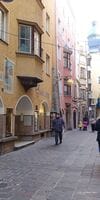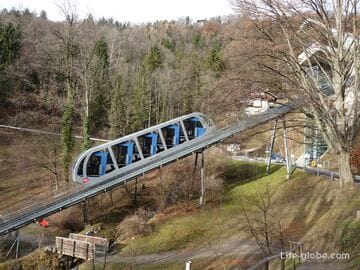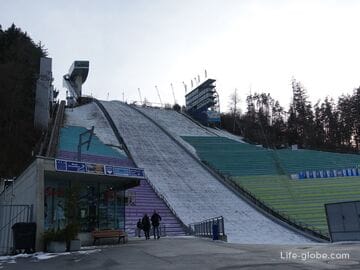The old town of Innsbruck (german name: Altstadt) is one of the statistical areas of Innsbruck, is part of the historical center of the city.
The old town of Innsbruck is the core of the historical centre of the city and, to a large extent, dates back to 1180.
Initially, the old city was surrounded by a powerful medieval ring wall and a moat.
Currently, the old city, and in a broader sense the entire historical center, is one of the main territories of modern Innsbruck, where the main tourist life takes place.
The old town is small in size and stretches just a few streets on the right Bank of the Inn river.
He keeps "his" one of the main attractions of Innsbruck. Here the narrow streets, most of which is a pedestrian area, framed on both sides with dense rows of striking historical buildings with luxurious exteriors, a variety of eye-catching Bay Windows.
During the history of the building of the historical centre was reconstructed, however, the General plan and style of historic Innsbruck was saved.
On the first floors of many buildings of the old town are shops, boutiques, cafes and restaurants.

Sights and streets of the old town of Innsbruck
Street Duke Frederick
Street Duke Frederick, the full name of the Herzog-Friedrich-straße (Herzog-Friedrich-Straße) is the Central street (main artery) of the old town of Innsbruck and one of the main pedestrian streets of the city centre, the second of Maria Theresa Strasse.
The street was named in honour of Frederick IV of Habsburg.
Its present appearance, the street has gained in the beginning of the new time, after due to several fires of the houses, some of which were then built of wood, the building was re-erected of more durable materials like stone, and for the extension of the street space, the first floors of buildings were converted into open arches (arcades), which are often decorated with frescoes.
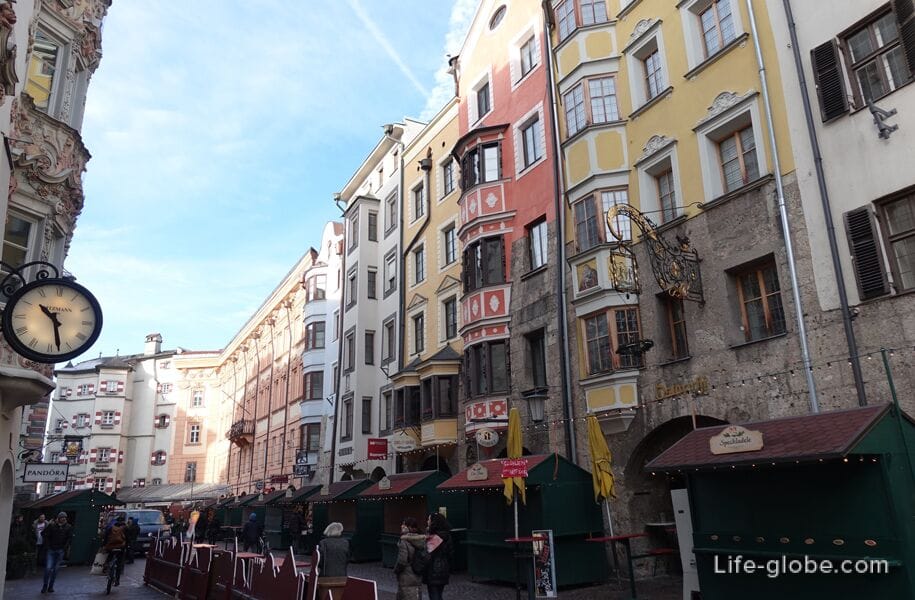
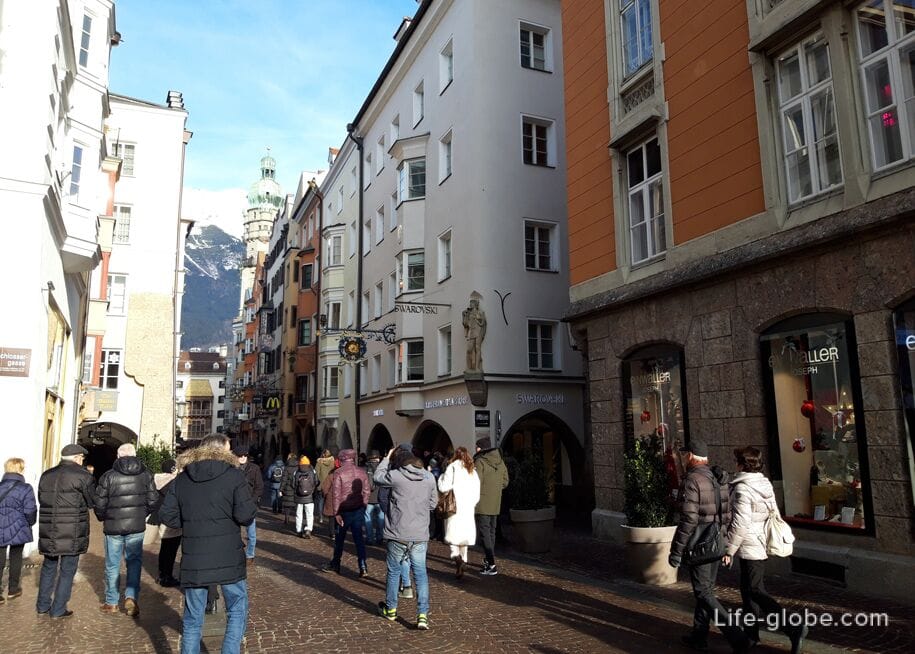

Main attractions the Herzog-Friedrich-Strasse are:
- Ottoburg (Ottoburg) - four - five-storey building of the late Gothic style, resembles a polygonal tower with protrusions and recesses on the facade.
The house was built on the corner of the city wall and connected with the inner gateway, demolished in 1790.
In its current form, the house was built in the years 1494-1495 and expanded in 1542.
The building has a restaurant. And in front of the building from the river Was placed a monument to the "Father and son", the work of Christian Plattner.
Address of building: Herzog-Friedrich-Straße 1;
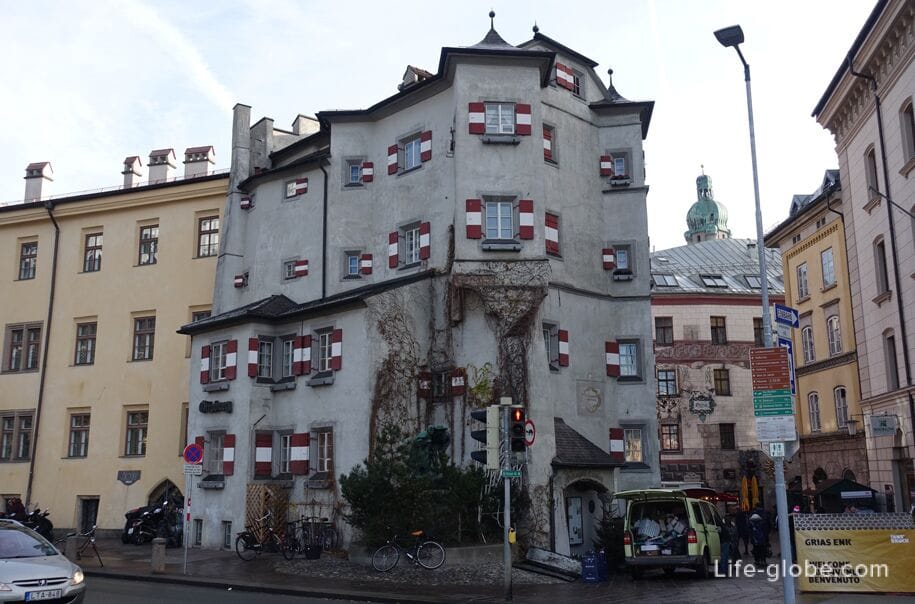
- Gasthof Goldener Adler (Gasthof Goldener Adler) - one of the oldest hotels in Innsbruck, which was founded in 1390 and rebuilt after a fire in 1450.
During the history in this hotel stayed a lot of important people. Late Gothic frescoes on the façade was reconstructed between 1957 and 1964.
In this beautiful historic building is currently located 4-star hotel Goldener Adler Innsbruck with a restaurant serving Tyrolean cuisine. Link to the hotel
Building address: Herzog-Friedrich-Straße 6;
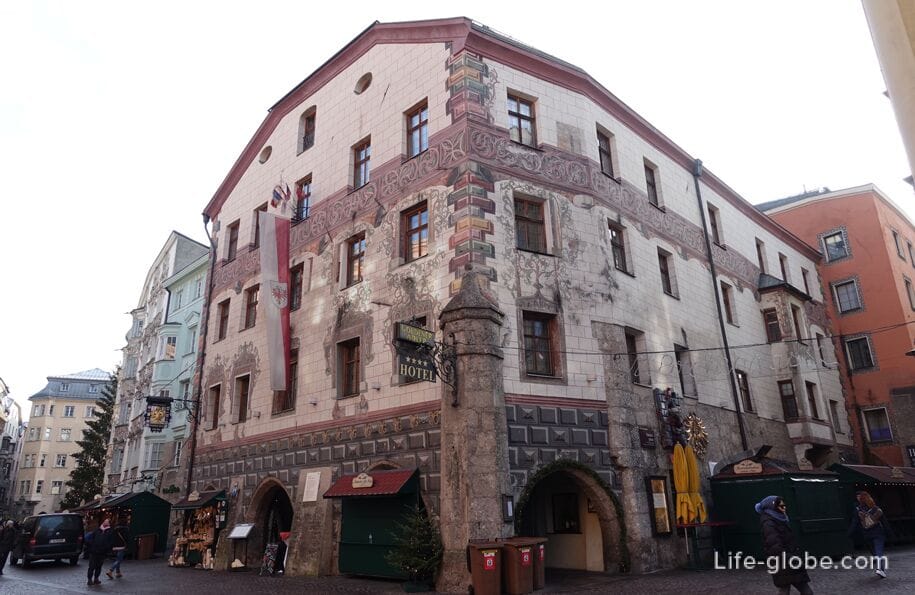
- house of Helbling / Helbling (Helblinghaus) which dates back from the 15th century.
Originally the house was a townhouse in the early Gothic style, like most of the surrounding buildings, but in 1725-1730 years purchased luxurious finish with stucco in Baroque - Rococo style, which can be seen today.
The architecture of the houses viewed: exquisite Bay Windows, flowers, fruit bundles, shells, masks, little angels and many other motives.
Address home: Herzog-Friedrich-Straße, 10. Read more about the house of Helbling...;
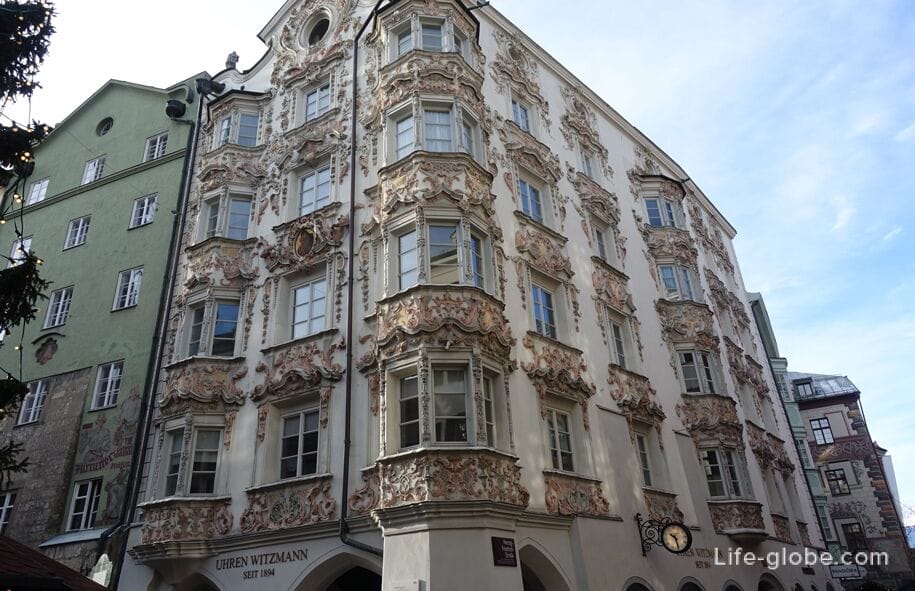
- the Golden roof or simply the Golden roof of Innsbruck (Goldenes Dachl) is one of the most recognizable buildings in the city, the facade of which is a Bay window, called the "Golden roof".
The Bay window is covered with 2 567 gold-plated copper tiles, giving the name of the restaurant "Golden roof". In addition, the facade of the balcony are covered with paintings and reliefs, consisting of scenes from the life of Emperor Maximilian I.
In the building with the Gold roof is currently a Museum of the Golden roof (Goldenes Dachl Museum), the exhibition which tells about the reign of Maximilian I and the history of Tyrol in the Middle ages. Museum website: innsbruck.gv.
Address "Golden roof": Herzog-Friedrich-Straße 15. Read more about the Golden roof...;
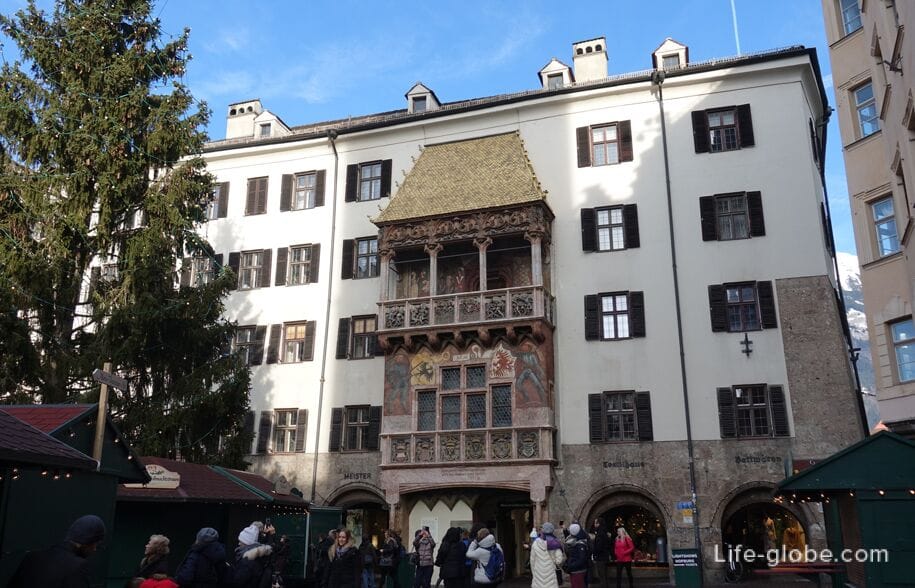
- "Urban square"located in the Central zone of the Herzog-Friedrich-straße - in front of the building with the Golden roof, in the dream where the street is extended and has a rectangular shape. This space used to be called town square, but today has no formal name.
Previously, the area was used as a venue for tournaments, public speeches and rallies.
In our days of the informal area is used for festivities. On the eve of Christmas and New year in the square and near such runs a large Christmas fair, and set the main Christmas tree of the city. Read more about all Christmas markets in Innsbruck...
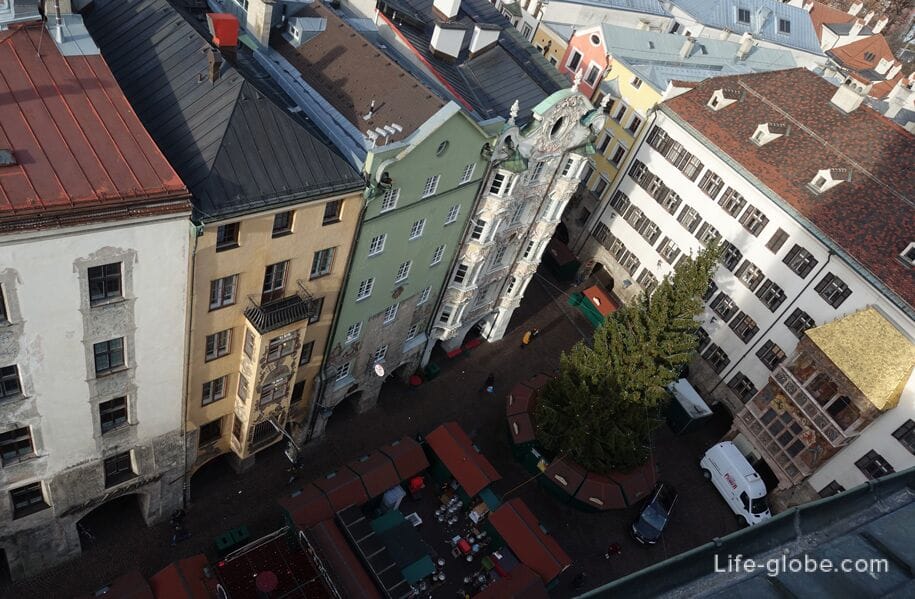
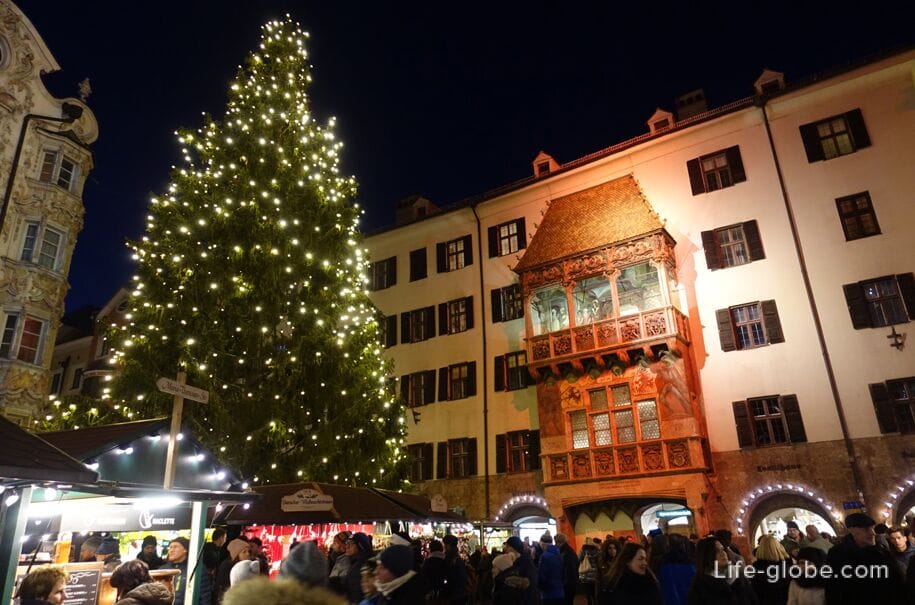
- old city hall with the city tower (Stadtturm). The town hall was built in 1358, and during the history has undergone several structural changes. Until 1897 the town hall was used as residence of the city authorities. On the main façade of the town hall you can see a relief of the coat of arms.
To the right side wall of the hall is adjacent to the high City clock tower, built between 1442 and 1450 years and at that time attached to the town hall. The tower was a lookout structure for the conduct of patrols, which was on duty hours and warned residents about fires and other impending dangers. The lower floors of the tower served as a prison.
On the city tower (altitude 31 m) is an open platform with an iron railing and mesh fencing, which is a circular observation deck that gives a 360 degree view on the Innsbruck, the historic centre, the mountains and the surrounding area.
Address of the tower and the old town hall: Herzog-Friedrich-Straße 21. Read more about city hall and city tower.

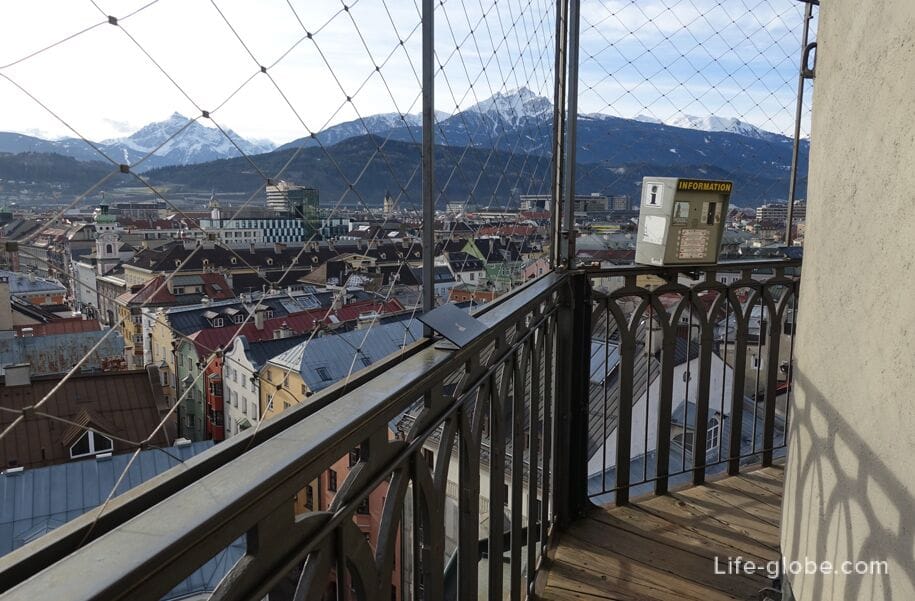
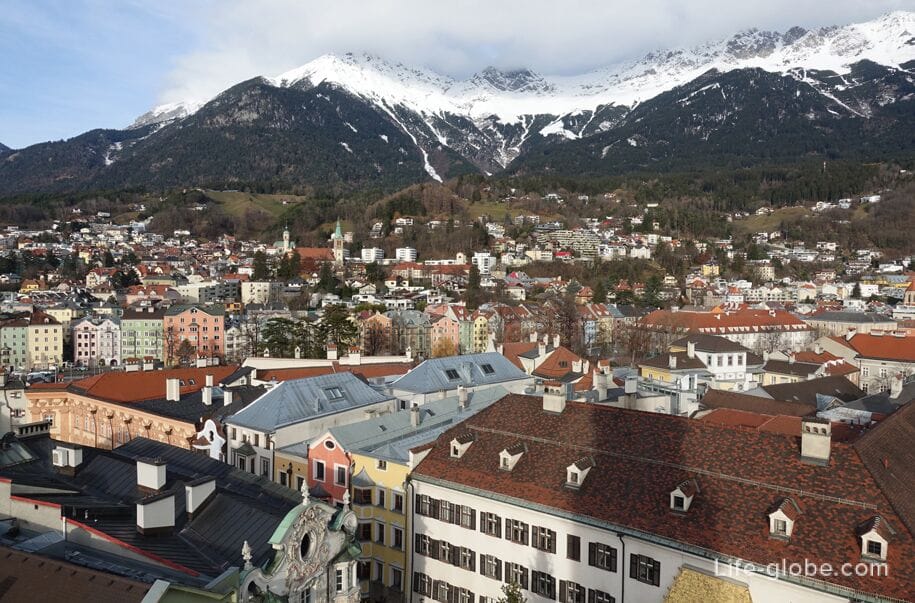
Read more about street Herzog-Friedrich-straße...
The residence of the Tyrolean rulers (the Hofburg and the Hofkirche)
The Hofburg (Imperial Palace, German title: Kaiserliche Hofburg) - the former Imperial Palace, located on the outskirts of the old town of Innsbruck.
The Hofburg is close to the main buildings of a larger complex that once built the Tyrolean rulers, which in a broad sense also includes the court Church Hofkirche, Tyrolean folk art Museum and the present: the Hofgarten, the Theological University, the Cathedral and Congress.
The Hofburg was built on the site once occupied by the wall fortifications and towers of the medieval town, part of which was integrated into the structure of the Palace.
The construction of the Palace began in 1453. In 1463 in the main hall of the Palace held a Banquet in honor of the construction of the residence.
During the history, the Palace was repeatedly expanded and restored, changing their appearance.
Currently, Hofburg is a complex of buildings (wings of the Palace) with white main facade, round towers, an inner courtyard, rooms and halls, a Gothic cellar and a chapel.
In the walls of the Imperial Palace hold receptions, gala dinners, exhibitions, presentations and events involving senior individuals.
The Palace is a Museum, the jewel of which is the main hall (Ball room) with frescoes on the ceiling and huge chandeliers. Museum website: hofburg-innsbruck.
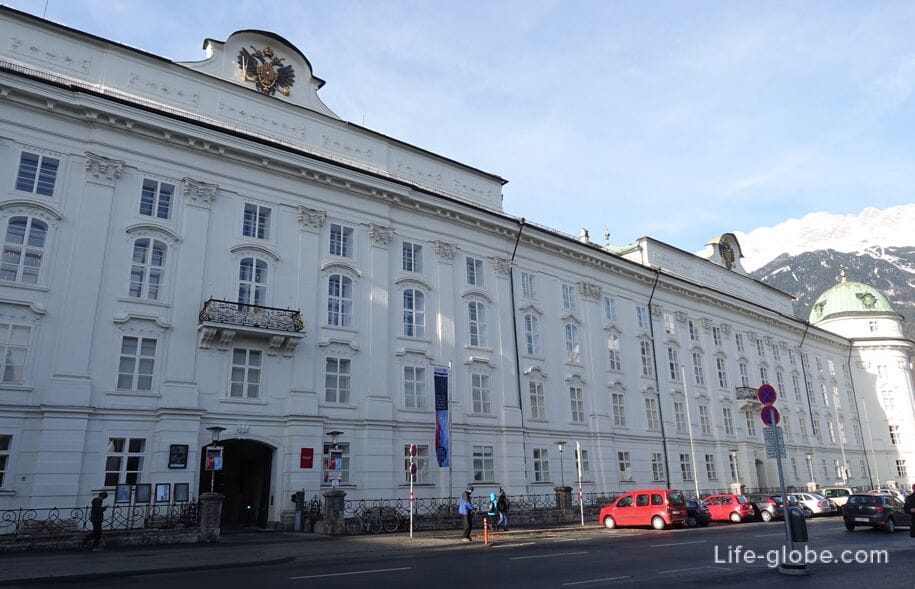
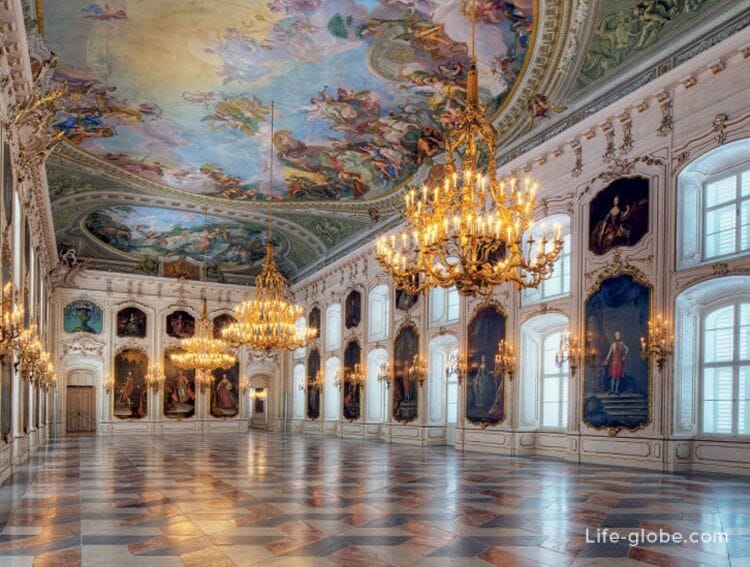
The Hofkirche (court Church - "Court Church") is the former Imperial court Church, a member of the Palace ensemble.
This Gothic Church is considered the best in Innsbruck. The Church and the adjacent Franciscan monastery was built in the period 1553-1563 years by Emperor Ferdinand I as a memorial of his grandfather the Emperor Maximilian I.
In the walls of the Church is a ceremonial tomb - Cenotaph (no body inside, only serve for memory and as a sign of honor) Maximilian I surrounded by 28 large black bronze statues of ancestors, relatives and heroes of the contemporaries of the Emperor. For this reason, the Church is also called Church "Black people".
Within the walls of the Church are buried some famous people: Andreas Hofer, his grandson Joseph, Katharina Lexan, and are also the tombs of Archduke Ferdinand II and his wife the Philippines, 'zer.
Other attractions in the Hofkirche include: Silver chapel (Silberne Kapell); on the Renaissance (1560) and the high altar, designed in 1755. Read more about residences of the rulers of Tyrol in Innsbruck...
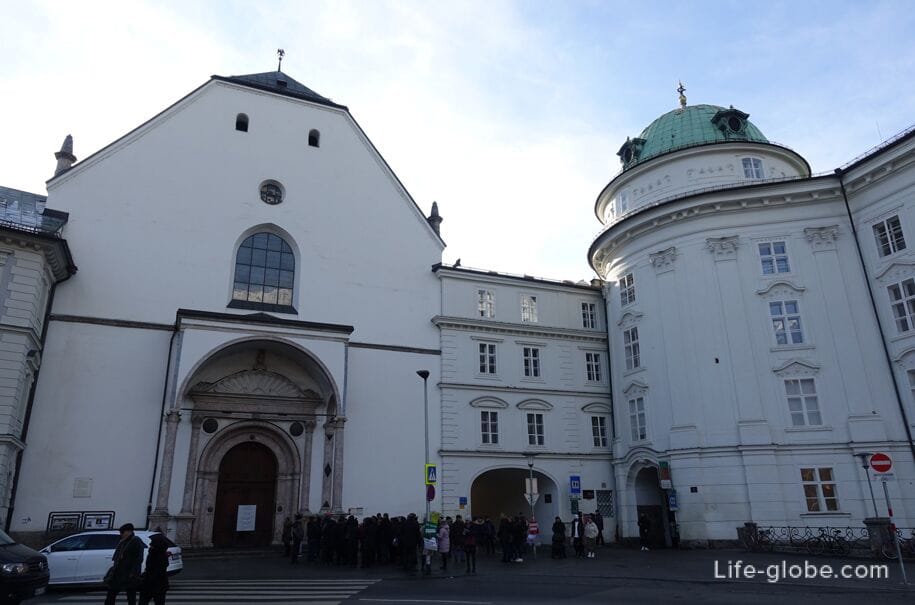
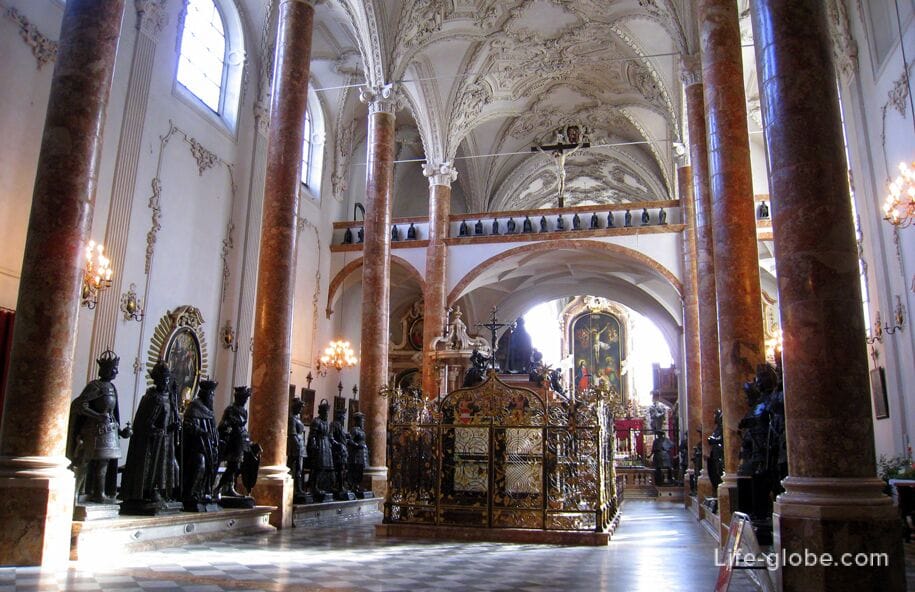
Tyrolean folk art Museum
To the left wall from the main portal Hofkirche adjacent historic building, the Tyrolean folk art Museum (Tiroler Volkskunstmuseum), located in the walls of the former Franciscan monastery around an arcade courtyard.
The Renaissance building with well-preserved monastery was built along with the Hofkirche and was used until 1785 as the Franciscan monastery, and then mainly as a school and since 1929, is home to the Museum of Tyrolean regional heritage.
The Museum contains important collection of cultural artifacts from the local traditions of the Tyrol. The Museum's collections include peasant Handicrafts and local items, including home: utensils, wood and wax; painted chests, tools, and den; ceramic and colorful traditional costumes, illustrating the diversity of the region and Tyrolean culture.
The Museum's site: tiroler-landesmuseen.
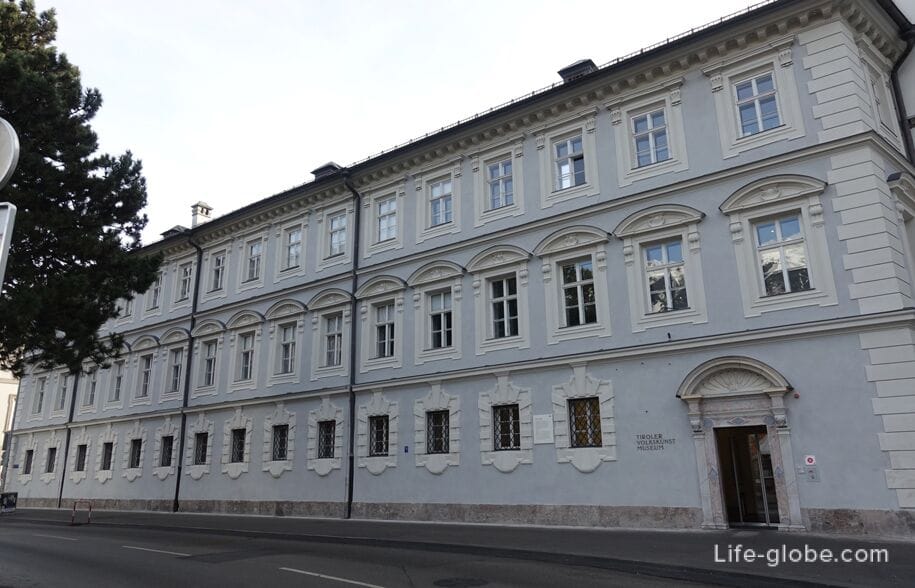
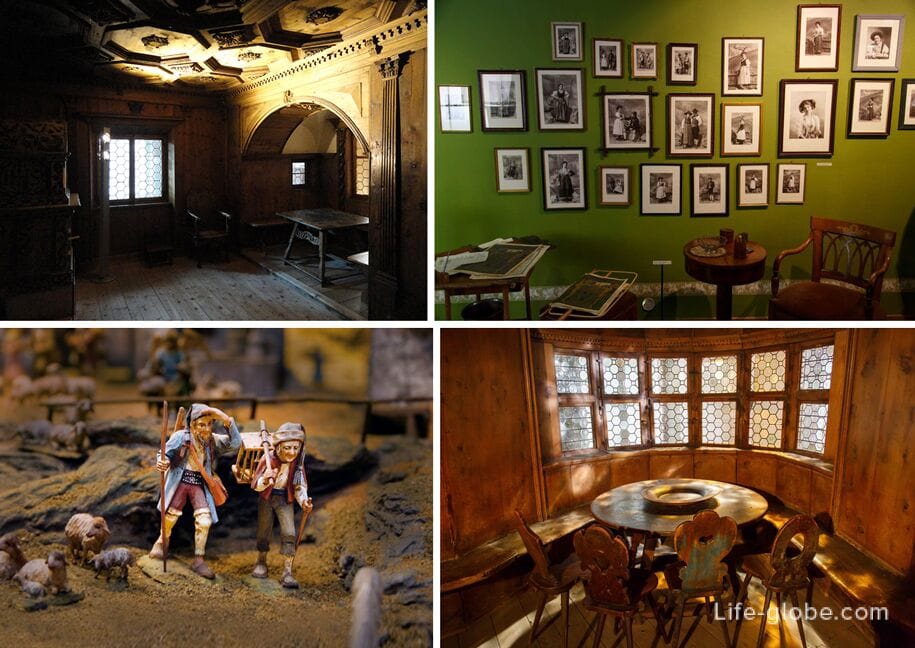
Cathedral of St. James (now the Cathedral)
Cathedral of Saint James / Jacob (Dom zu St. Jakom) is the main Catholic Church of the city.
The appearance of the Cathedral is rather modest and austere. However, unlike the exterior, the interior has a luxurious Baroque interior, where bright colors play marble, frescos and stucco work where sculpture and sculptural composition.
The Cathedral's address: Domplatz 6. Read more about Cathedral of St. James...
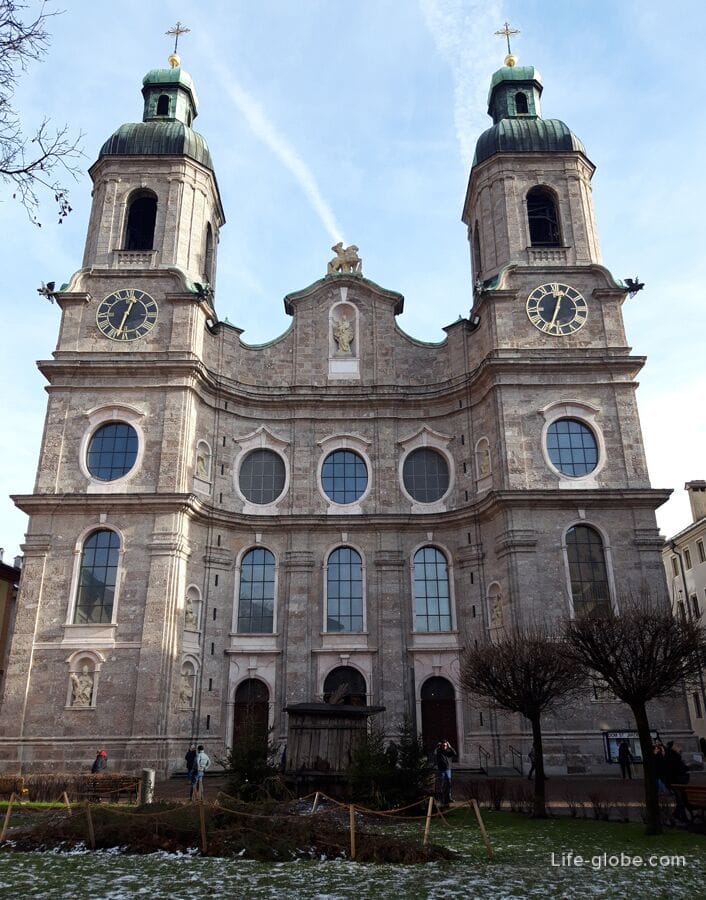
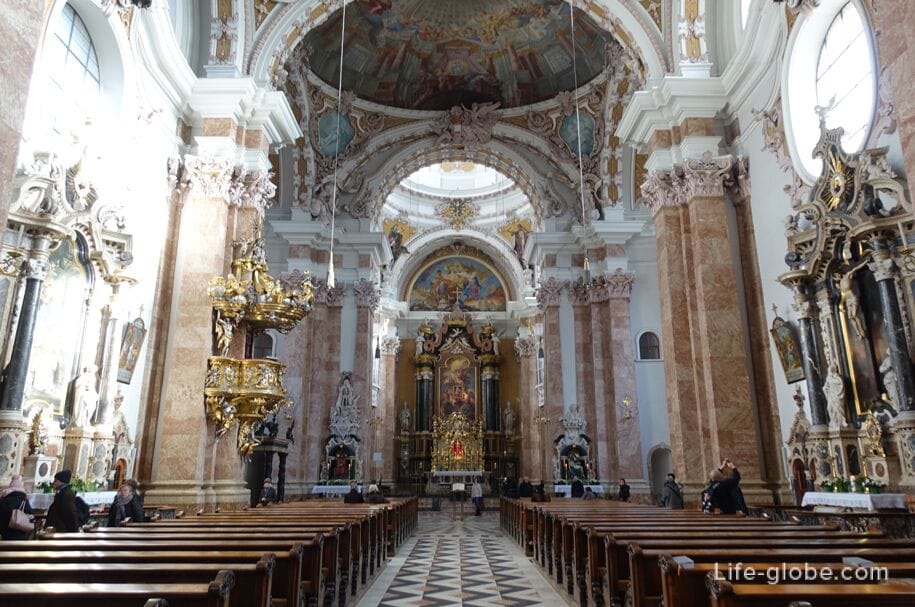
The main facade of the Cathedral of St. James opens onto a small square Domplatz (Domplatz), which, in addition to the Cathedral, surrounded by historic buildings in the old town of Innsbruck.

Holy Trinity Jesuit Church and the University
Jesuit Church or the University Church (Jesuitenkirche) dedicated to the Holy Trinity, built from 1619 to 1640 years and serves as the University Church and about it, as in the beginning of the history of the Church, care of the Jesuits.
The Church was built on the model of ancient Roman religious buildings. From the beginning the Church was closely connected with the Jesuits, and its members held theological classes in the University since its founding in the 17th century.
Christoph Gampp, a member of the famous dynasty of masters of Innsbruck, designed the facade of the Church.
The interior of the Church is remarkable: the altarpiece in the Baroque style, the monumental dome and the organ.
In the crypt of the Church are the graves of Archduke Leopold V and Claudia.
The address of the Church: Karl-Rahner-Platz 2.

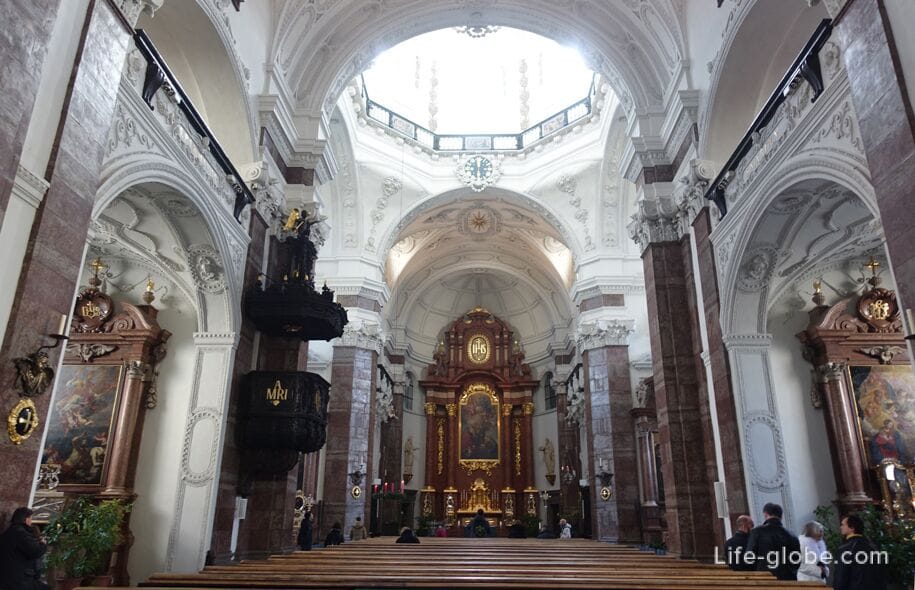
Near the Church is an old building of the University (Theological University).
The Western part of the building with a corner crest was built in 1562 during the construction of the Innsbruck Jesuit College, including the Church of St. Salvator about 1499. The Eastern part was built before 1672-1673 years after the construction of the Church of the Jesuits (the Foundation was laid about 1627). In 1776, the University moved.
Address University building: Universitätsstraße, 6.
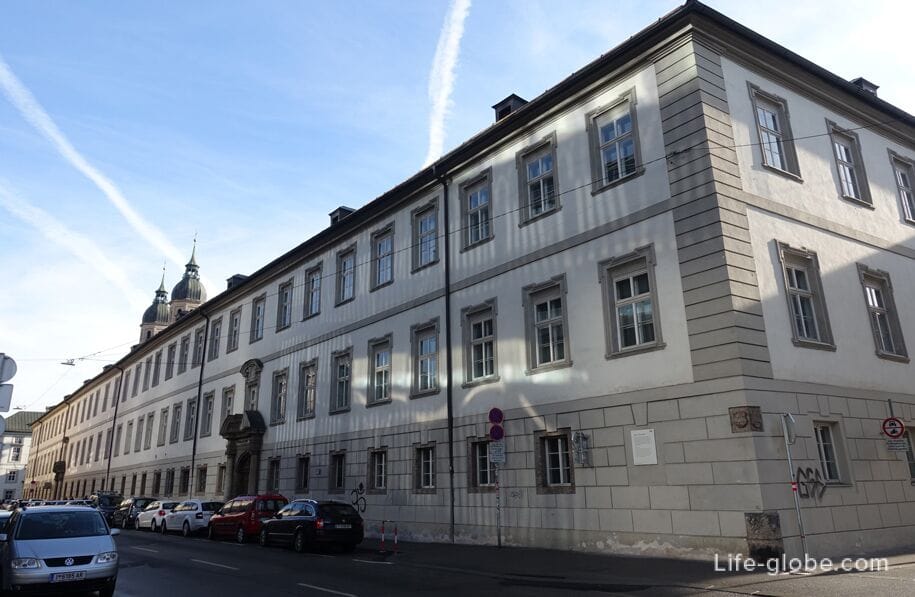
Tyrolean provincial Museum ferdinandeum
The Tyrolean Museum ferdinandeum (Ferdinandeum Tiroler Landesmuseen) is part of the Tyrolean state Museum and is located in a large historic building in neo-Renaissance style, architect and master Builder of which was Anton Musclecar (1842-1845 years).
The creation of the Museum dates back to 1823. Originally the Museum collection was located in rented rooms in the Abbey Wilten and in the University building.
The building of the new Museum was opened on may 15, 1845 and was one of the first buildings on the newly created street, on the current Museum street (Museumstrasse). Later the Museum building was expanded and remodeled several times, including adding another floor and wing, and the facade acquired their present form (1867 - 1998).
The upper part of the facade of the Museum is crowned with a 3-meter statue of Tyrol, Minerva at left and allegory of the arts on the right. The sculptural group was designed by Joseph Gasser von Valhrona and made Antonio Spagnoli.
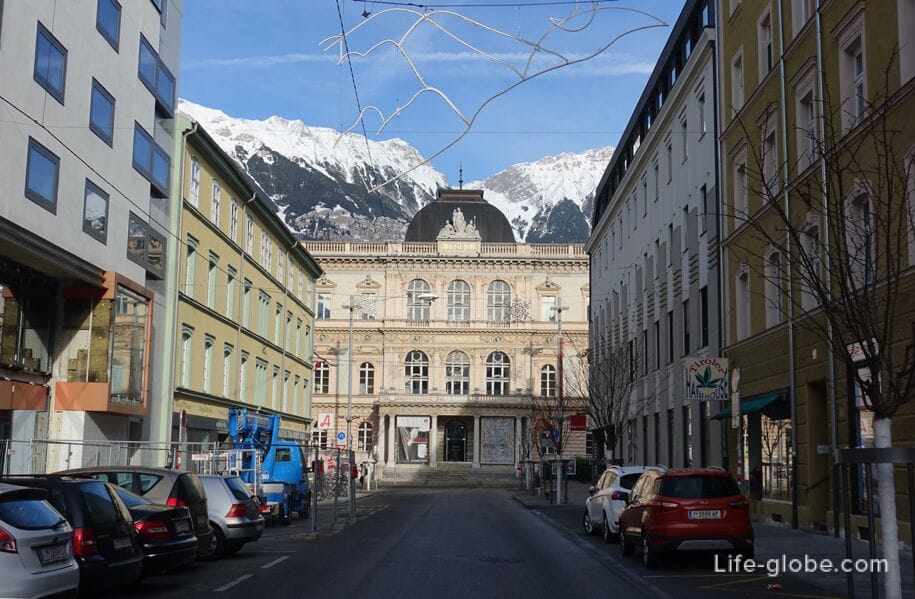
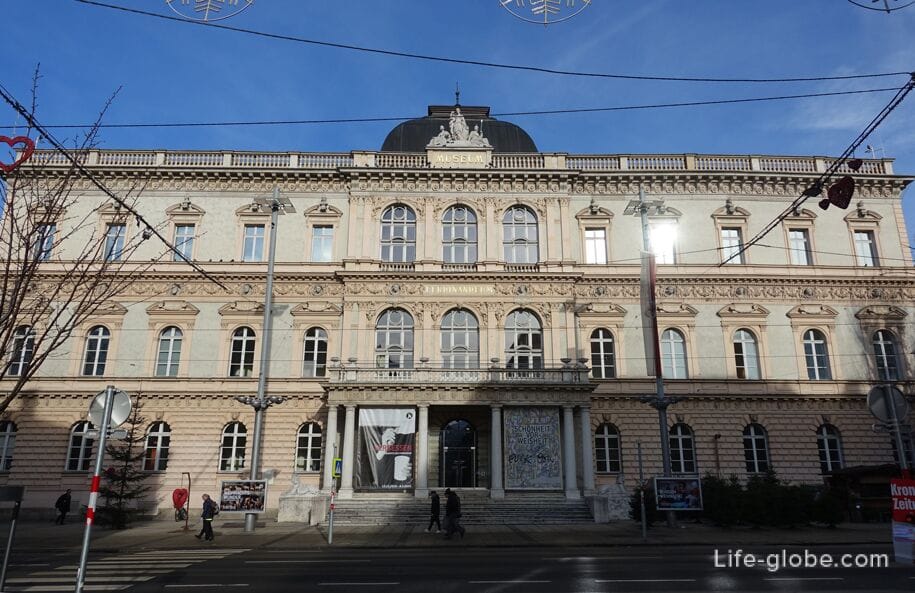
The Museum collection tells the history of the Tirol region, and not only - from the stone age to modern times: relics, Handicrafts, collections of works of art, drawings, engravings, photography, manuscripts, sculptures, musical instruments, library Fund, etc.
The Museum's site: tiroler-landesmuseen.
Address: Museumstraße, 15.
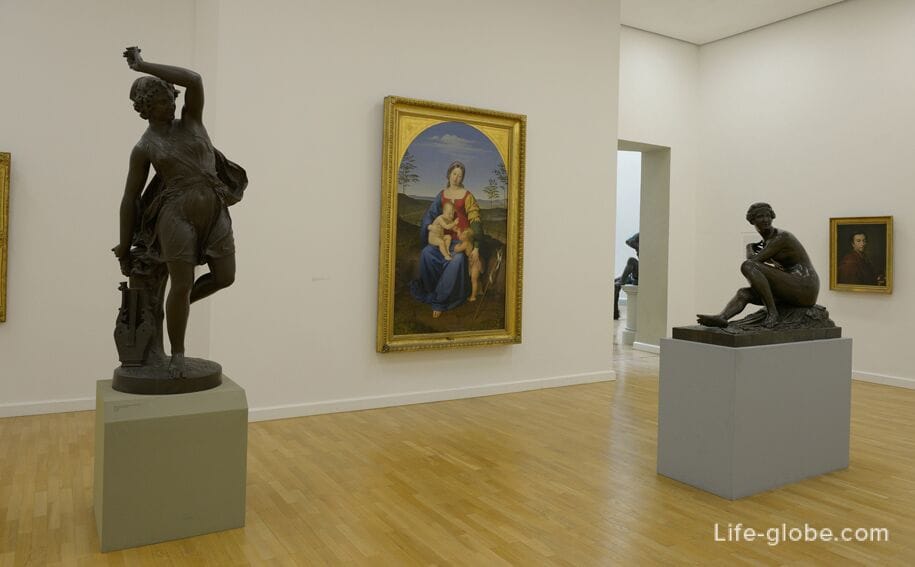
Near the East side of the facade of the Museum is the historic fountain-well.
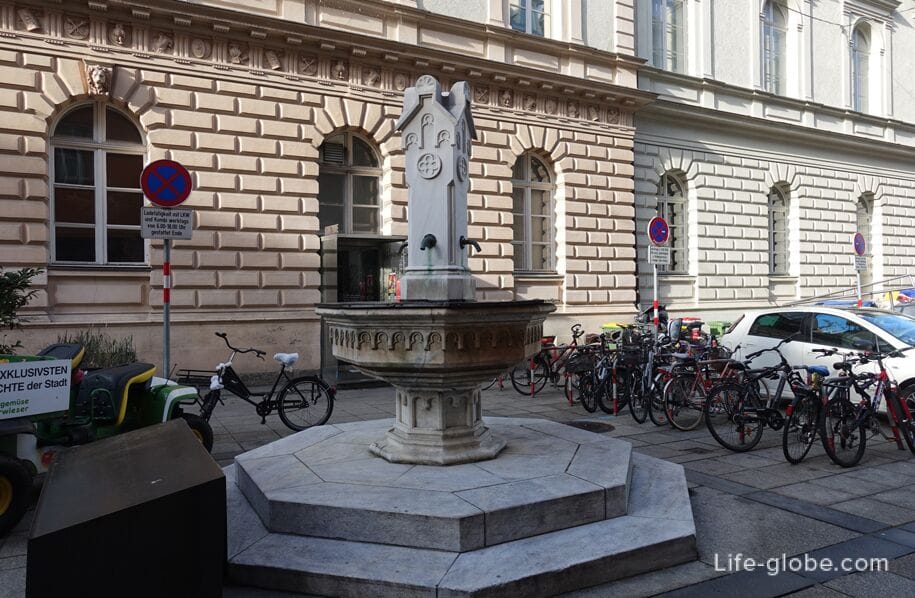
Indexhow (Andechshof)
At the end of the 12th century the counts of Andechs established the first Church for the state of princes to Inspire. Since the 15th century the building was rebuilt as "internal" Arsenal, and since 1775 - like barracks.
During the reconstruction of the Barracks "Was" from 1851 to 1853 is preserved only the exterior walls of the old building.
The address of the building: Innrain, 1.
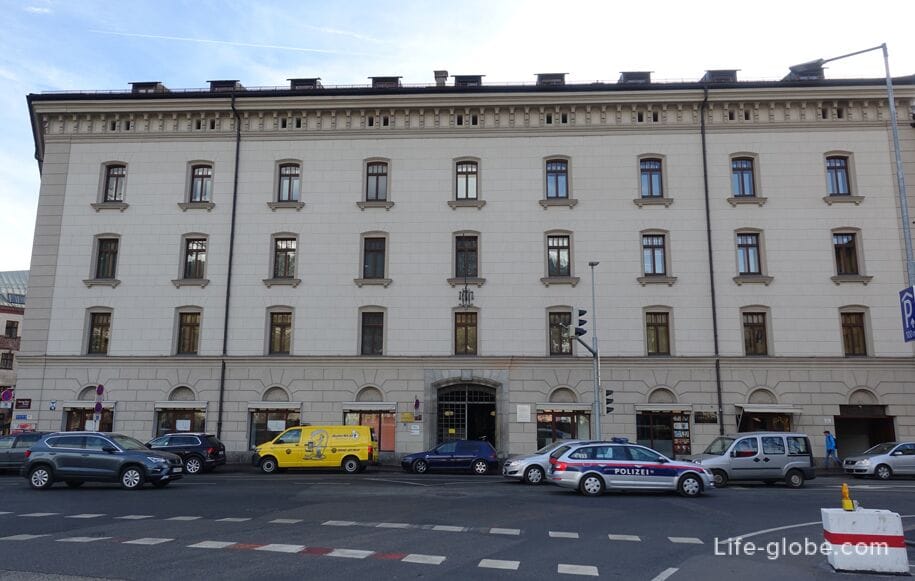
Other streets of the old town of Innsbruck
In the old town of Innsbruck, mostly from Herzog-Friedrich-Strasse, diverge in different directions of the secondary streets.
These streets are also popular tourist routes.
Streets lined with historic buildings, among which there is significant structure.
Street Seilergasse (Seilergasse)
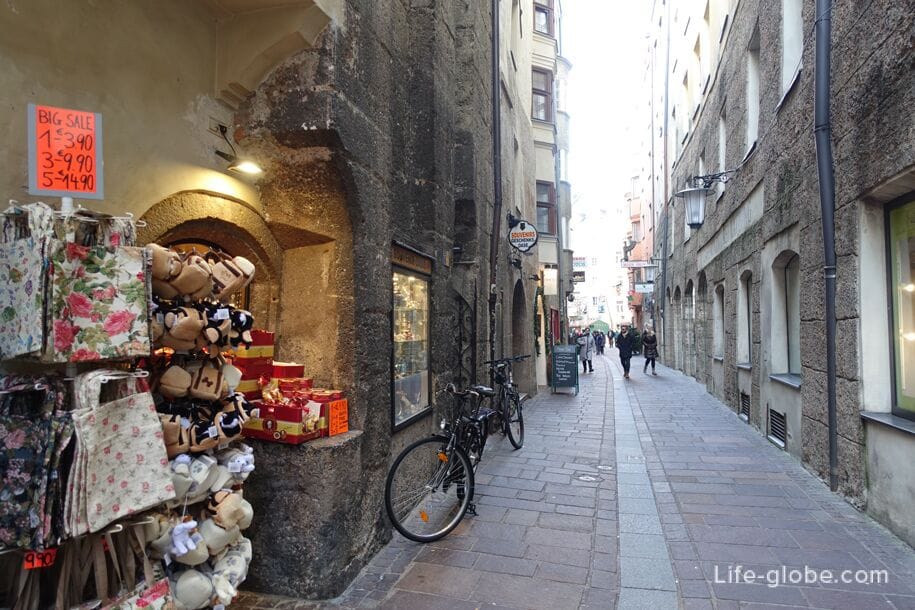
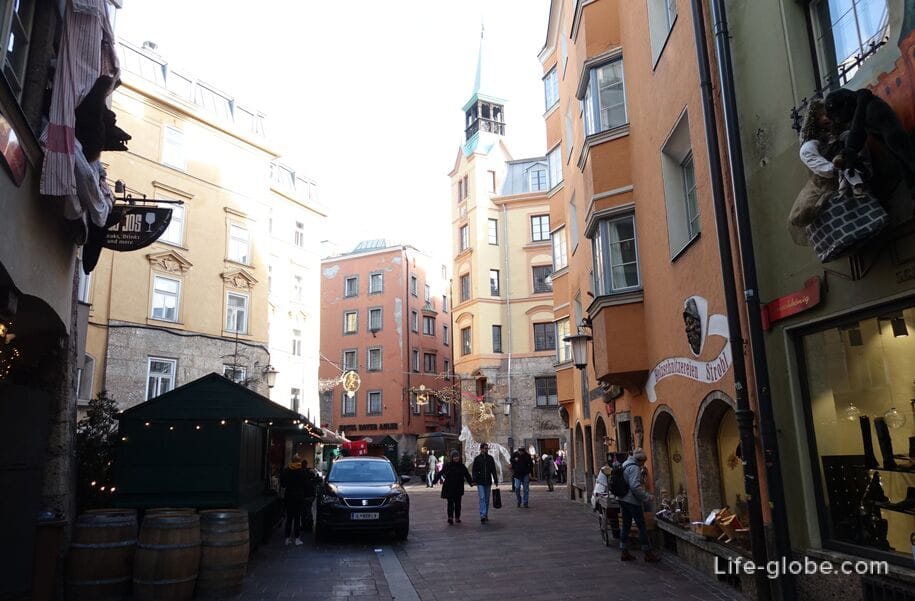

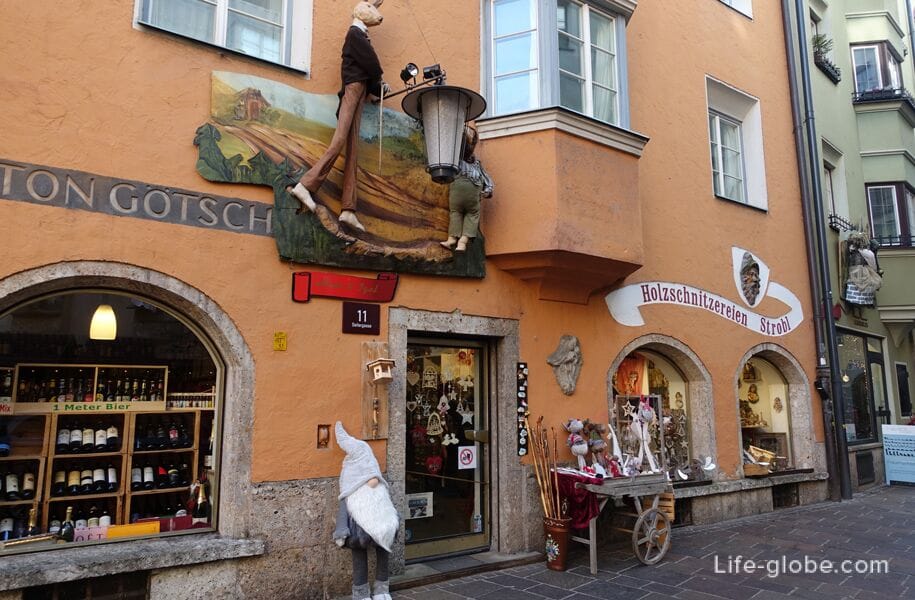
Street Kobajasi (Kiebachgasse)
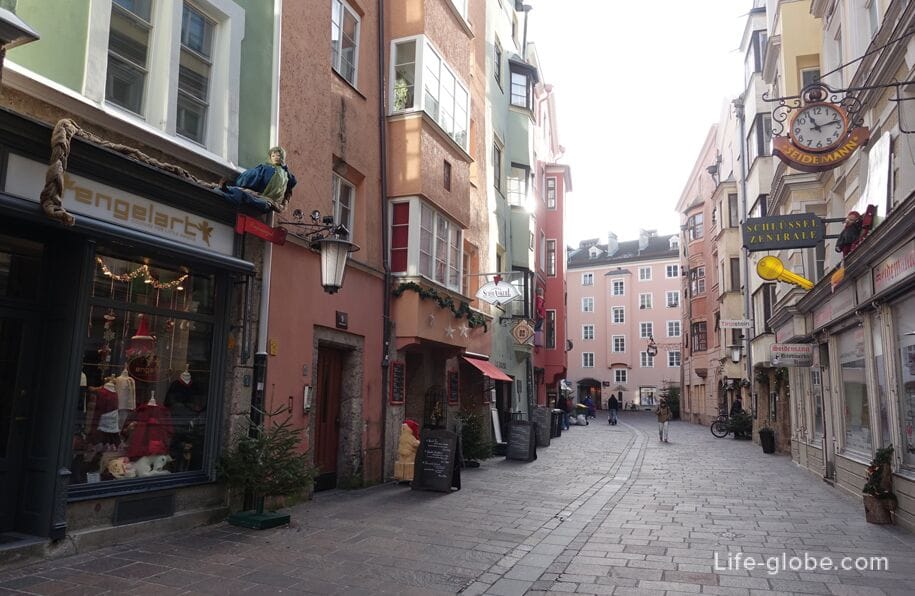

Street Riesengasse (Riesengasse)
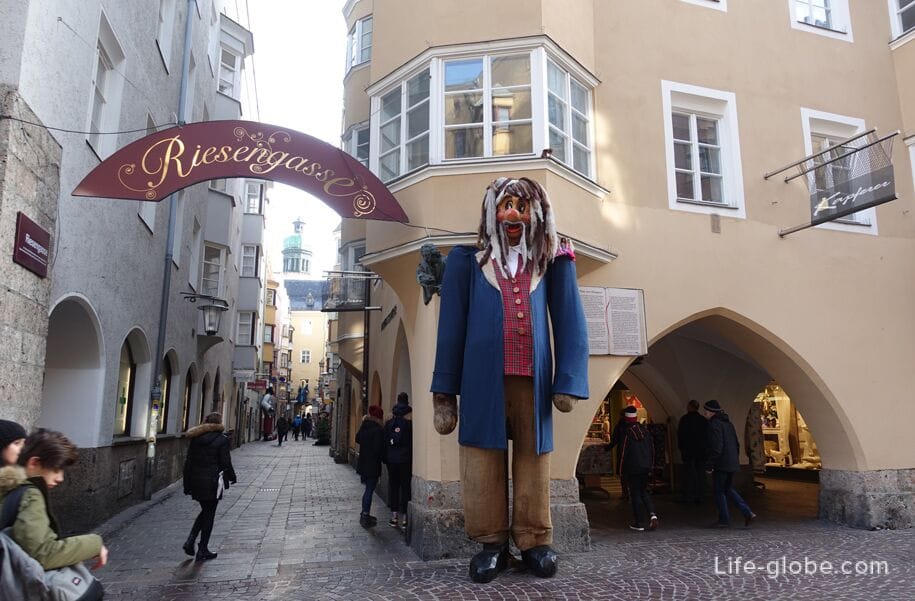
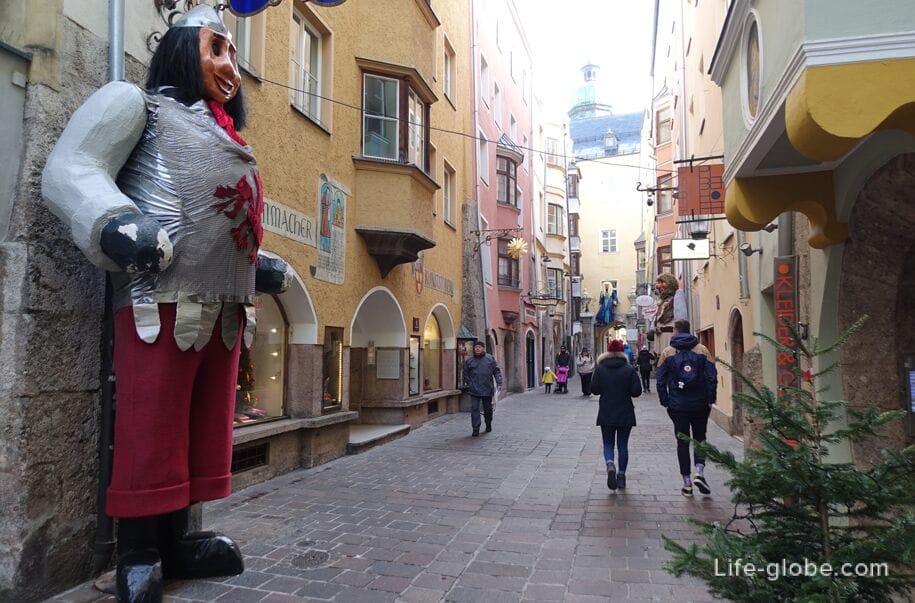
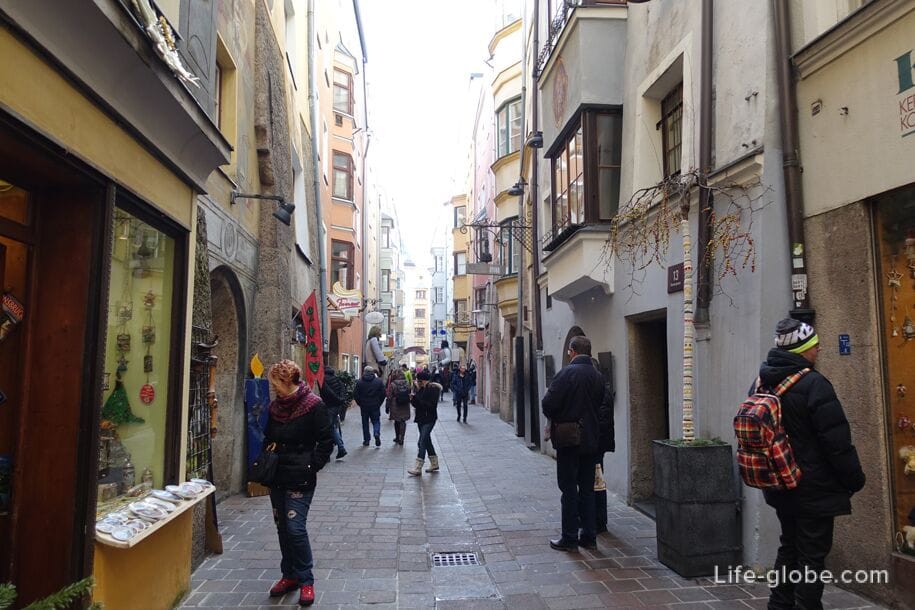
Street Hofgasse (Hofgasse)
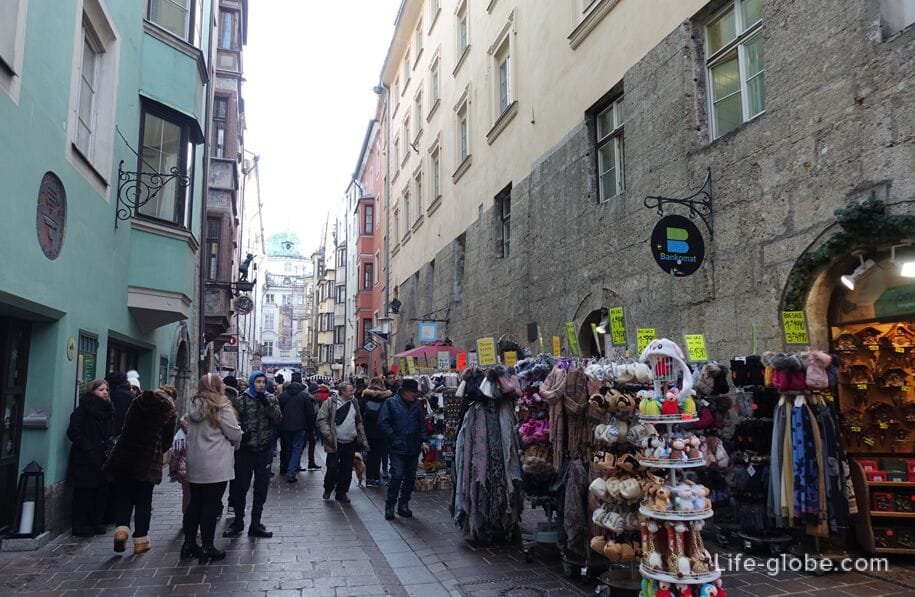
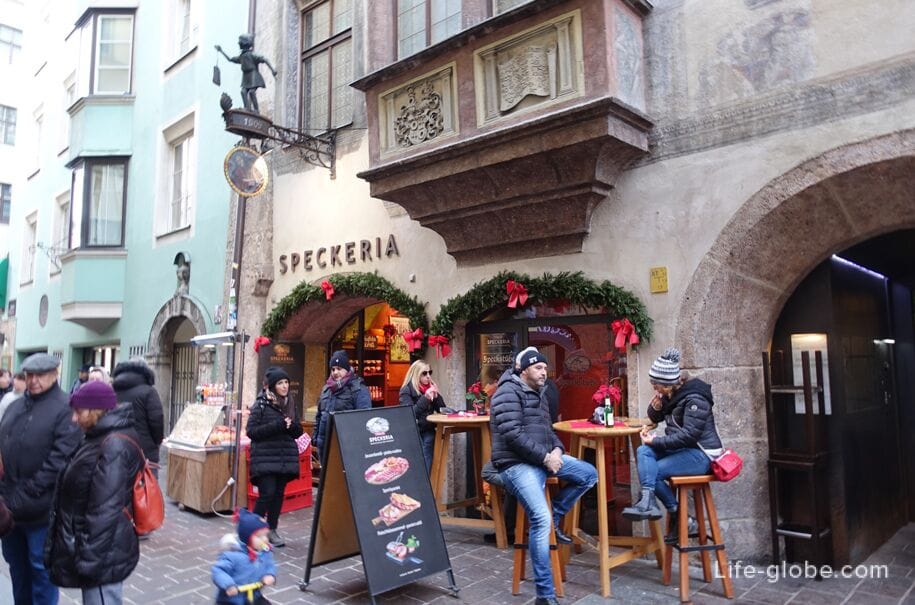
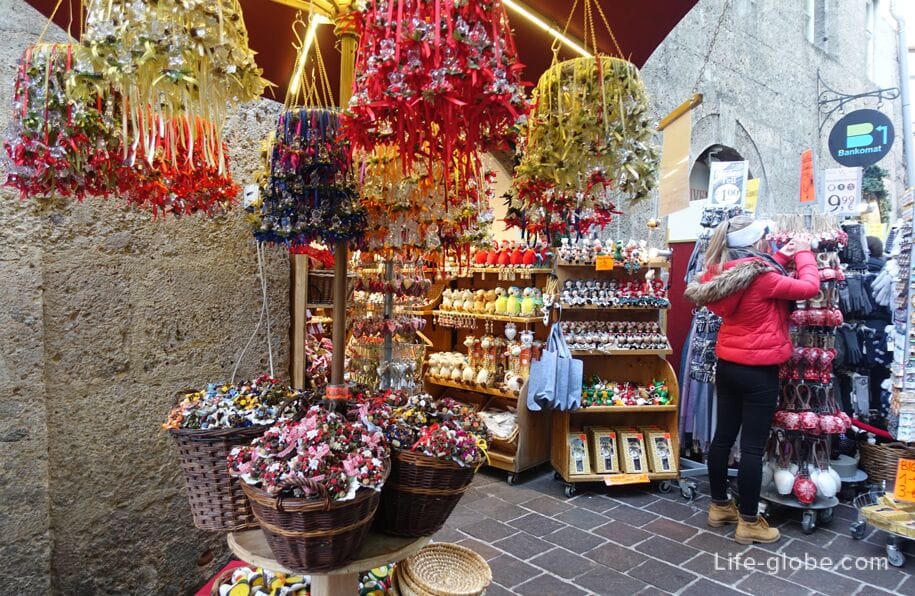
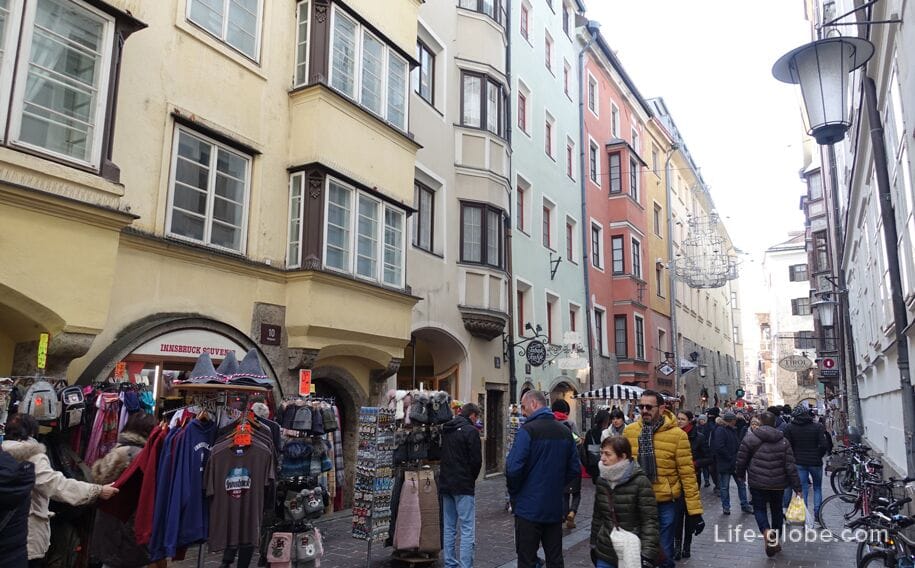
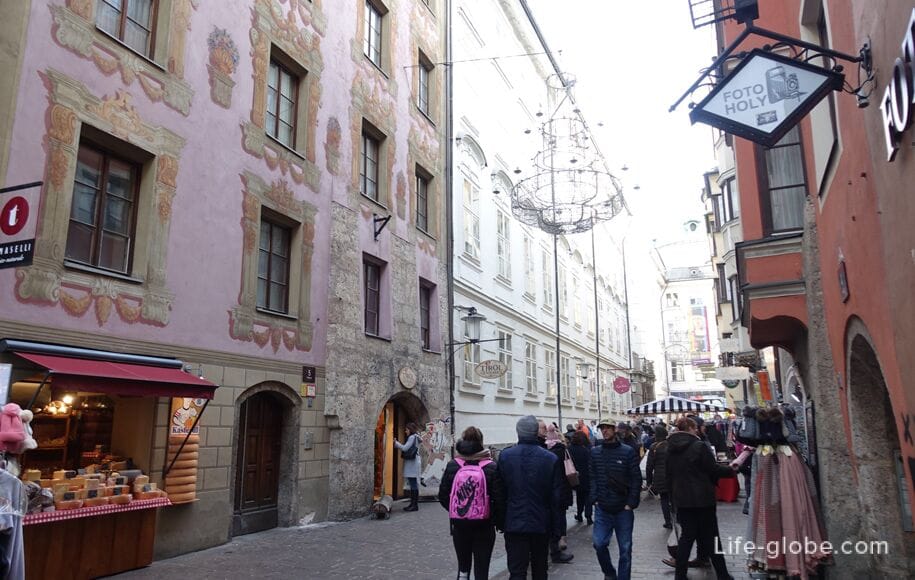
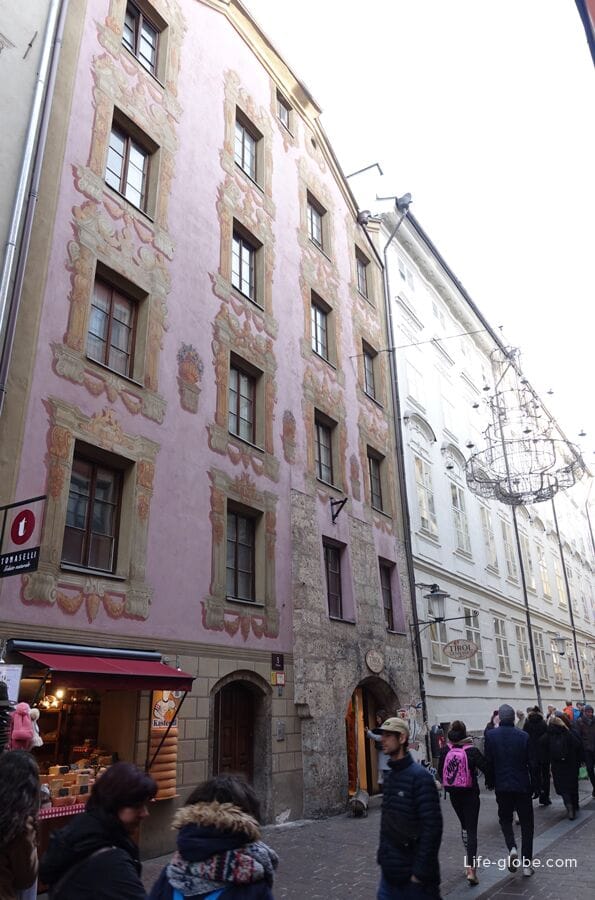
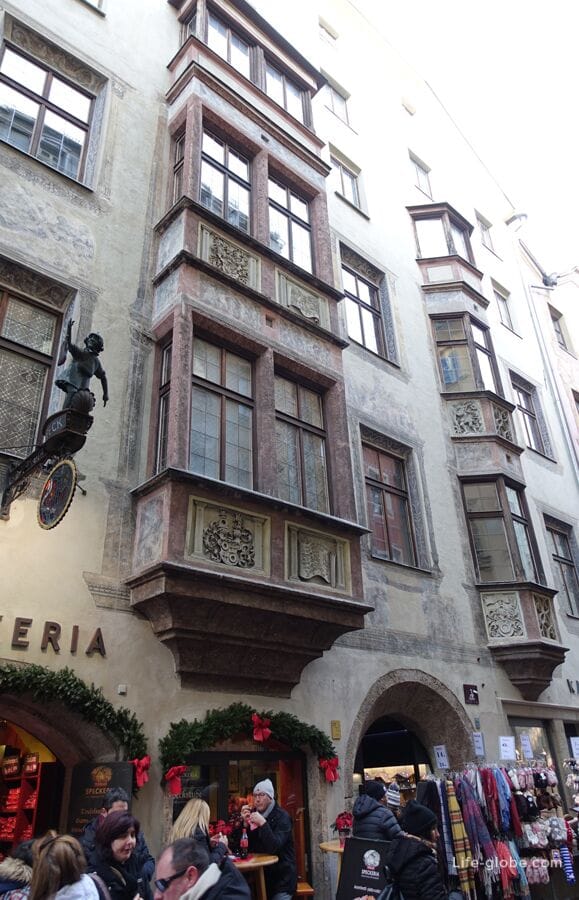
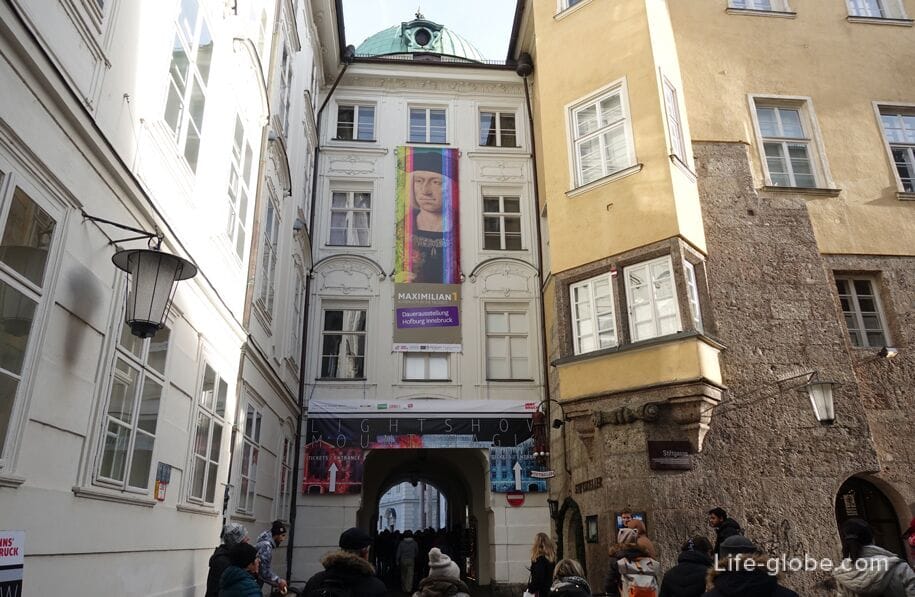
Street Stiftgasse (Stiftgasse)

Street Pfarrgasse (Pfarrgasse)
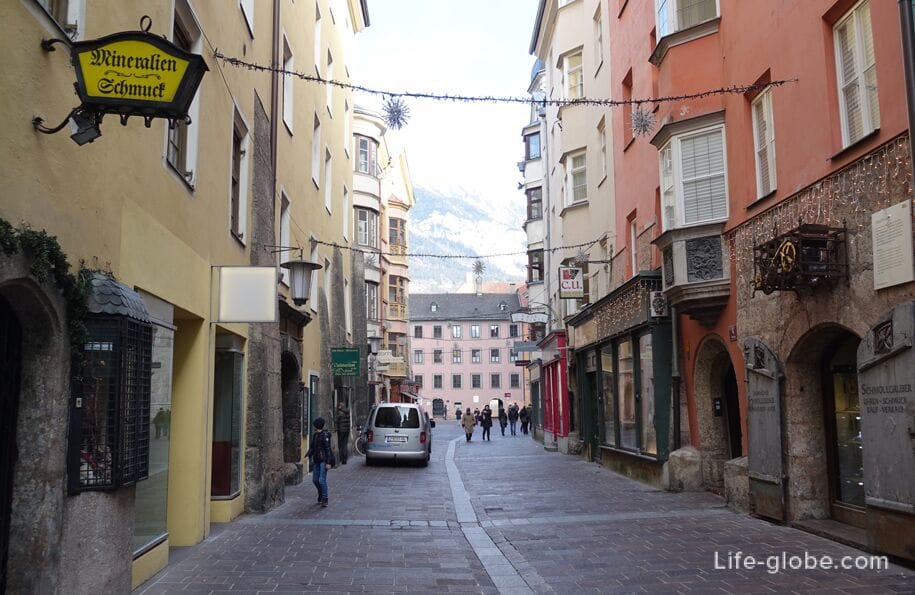
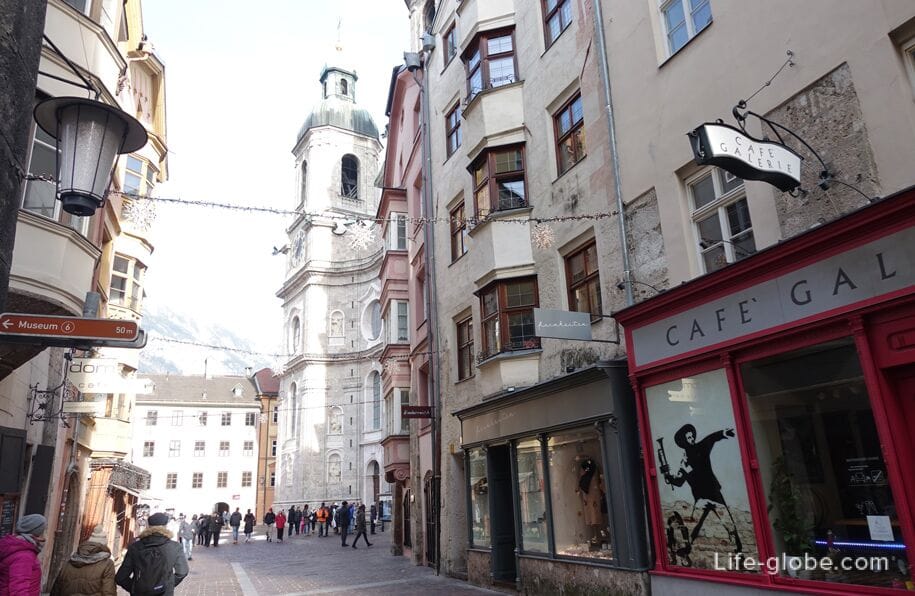
On the street Pfarrgasse remarkable:
- the house of Precht (Prechthaus) Dating from the 15th century and rebuilt around 1540 by Gregor Turing under the guidance of Dr. Basilius of Precht.
In 1588, the building was purchased by the Chancellor of the court of Justinian Moser. In the 17th century the house belonged to the counts of Stachelburg. With 1675 there was a court bookstore Wagner (until 1875) and University press (up to 1888).
Home address: Pfarrgasse, 4;
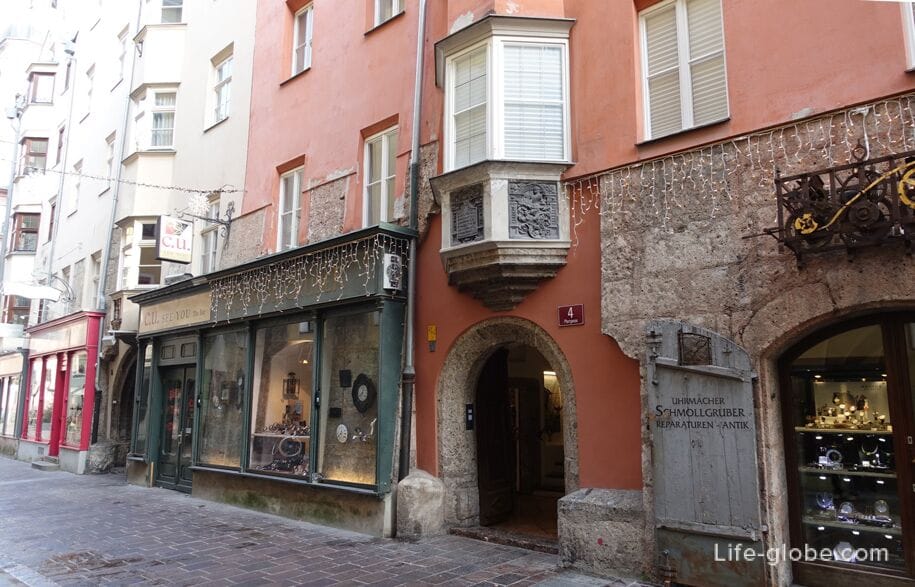
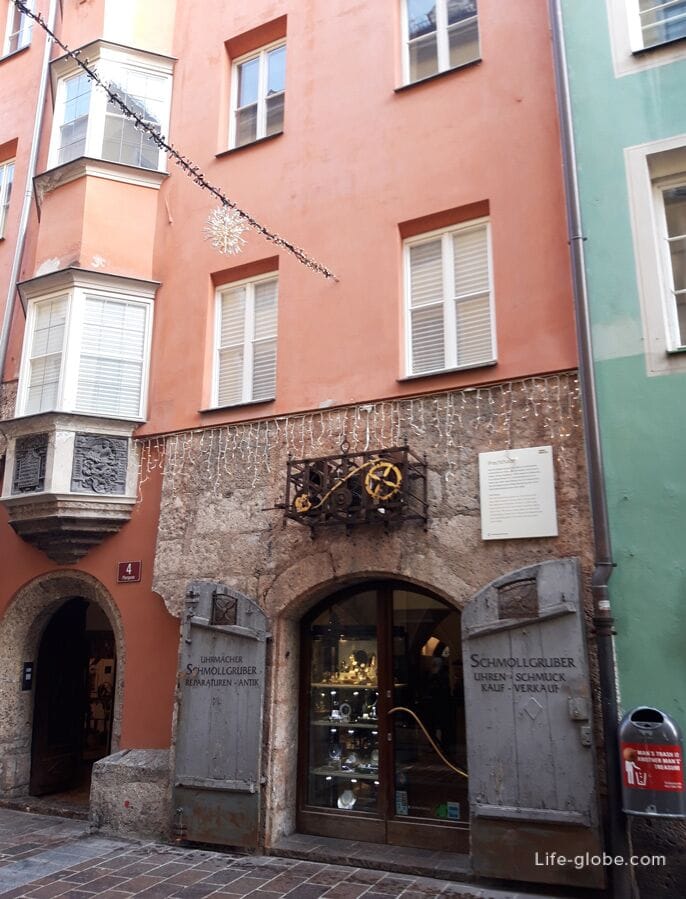
- the home of Marco Antonio of Honor.
Composer of the Baroque period mark Antonio Honor about 1654 he moved to Innsbruck to become the head of the planned theater. He was given a house on Prince Pfarrgasse, 5.
In 1665 he became Vice-Kapellmeister at the court of Leopold I in Vienna, for which he composed the wedding ceremonial Opera "the Golden Apple". In addition to a large number of cantatas, he wrote 15 operas for theatres in Venice, Innsbruck and Vienna. Antonio's Honor was considered one of the greatest composers of his time.
The inscription on the plaque on the house: "For the renovation of this house the city of Innsbruck was awarded the Europe Nostra in 1984".
Home address: Pfarrgasse, 5 / Domplatz.
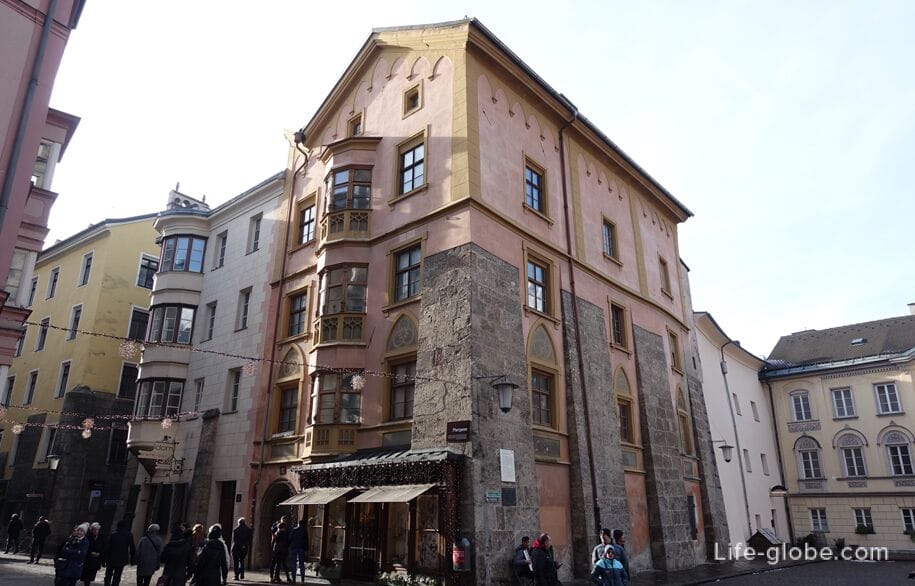
Street Badgasse (Badgasse)
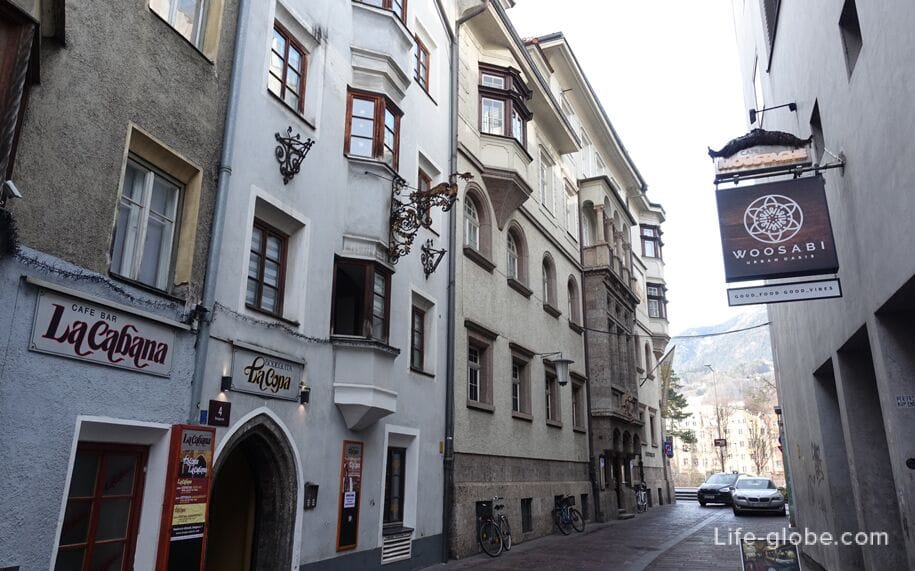
On the street Badgasse remarkable historic building which houses the City Museum/city archives (Stadtarchiv/Stadtmuseum), in the permanent exhibition which presents the main aspects of the history of the city from funds of the archive.
The website of the archive-Museum: innsbruck.gv.
Address of the archive-Museum: Badgasse, 2.
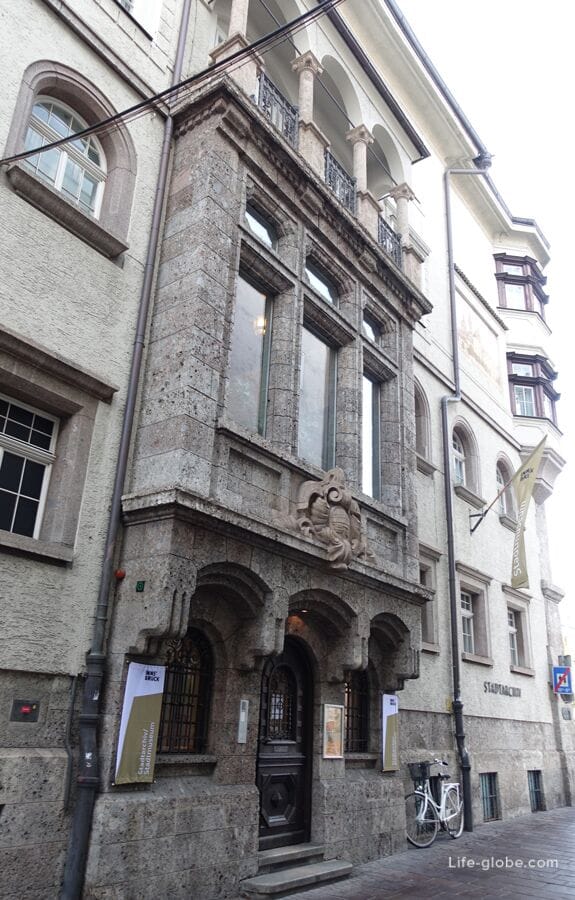
Street Laserase (Schlossergasse)

Street Burggraben (Burggraben)
From the street visible side and rear facades of the Hofkirche. On the eve of Christmas and New year on the street has a small Bazaar.

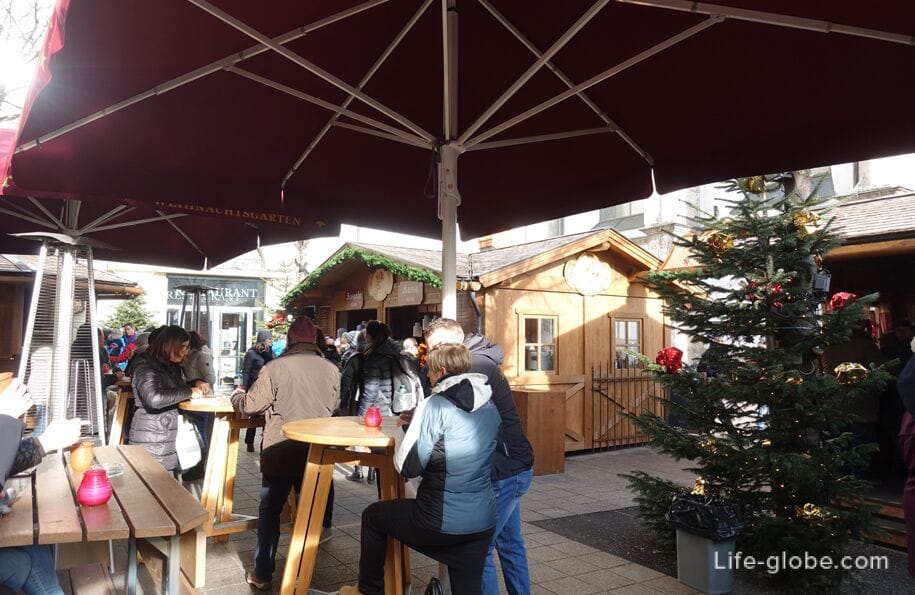
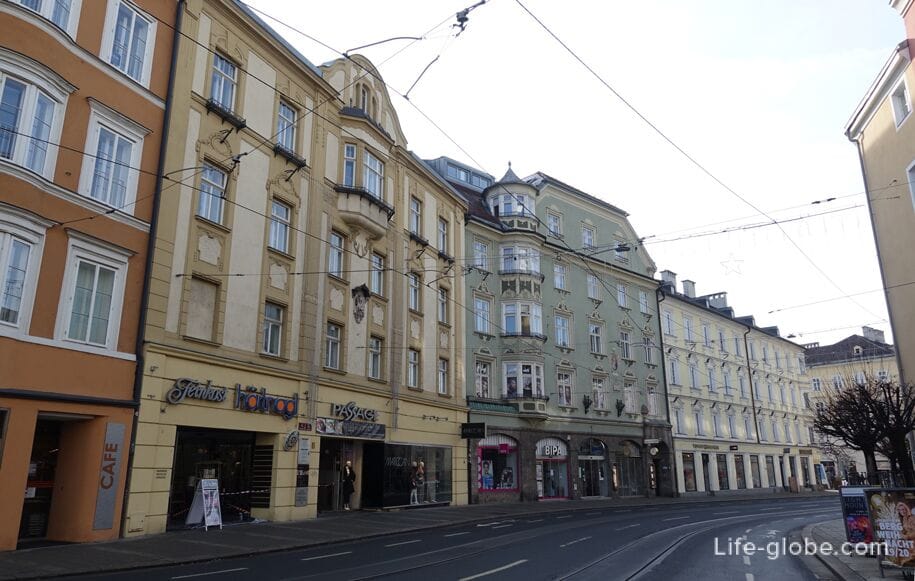

Street Burggraben leads to the southern tip of the old town, where he meets the street Museumsstrasse (Museumstraße) and the street Marktgraben (Marktgraben), who is also the southern boundary of the old city.
Photo street Museumstrasse
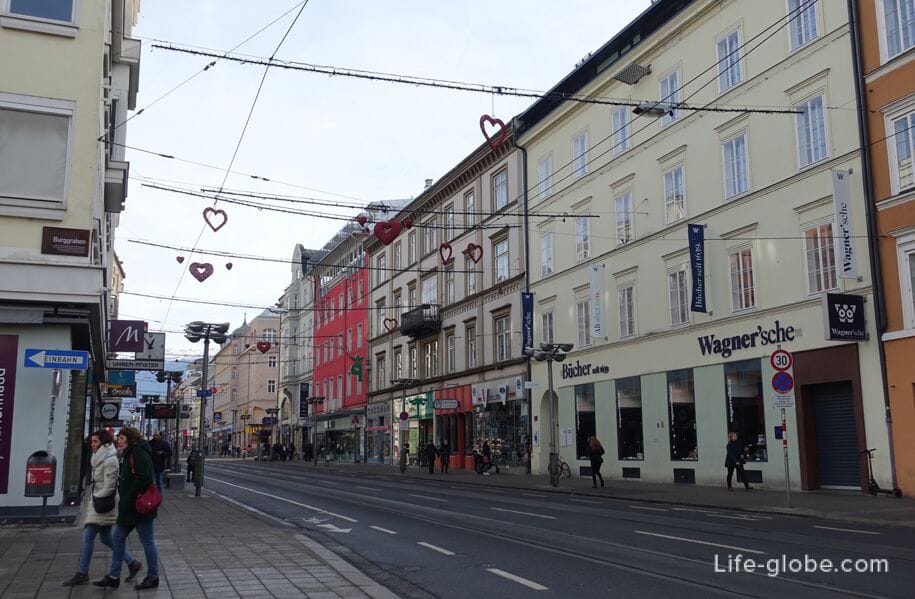
Photo street Marktgraben
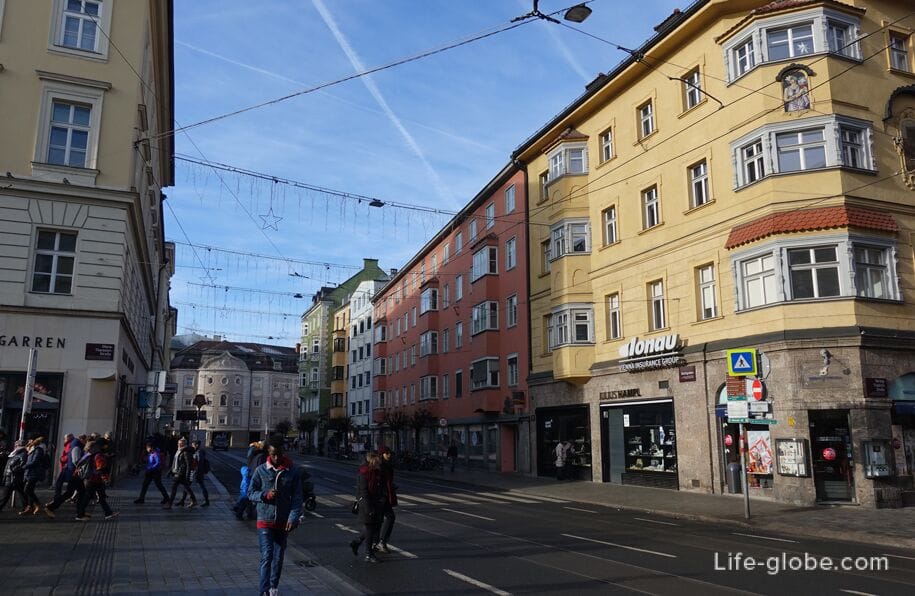
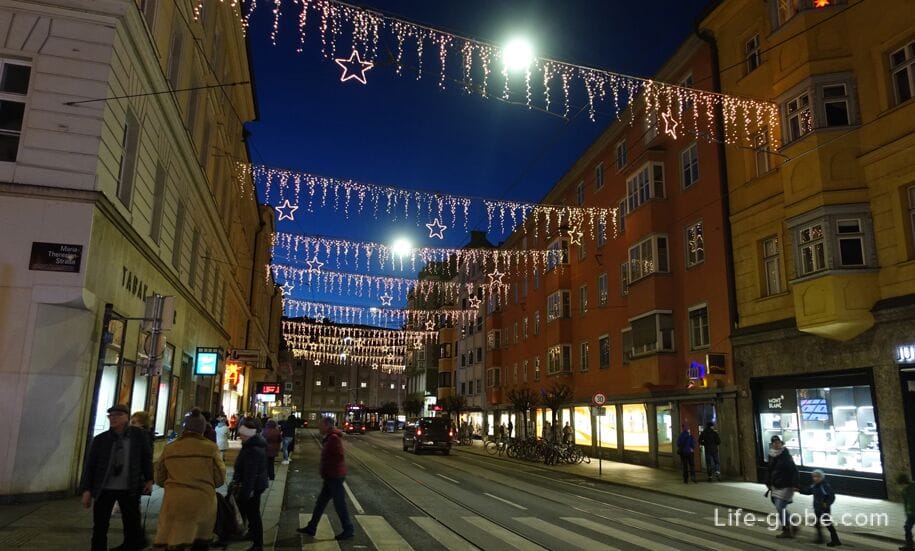
Street Sillgasse (Sillgasse)
Street Sillgasse delineates the Western border of the old town.
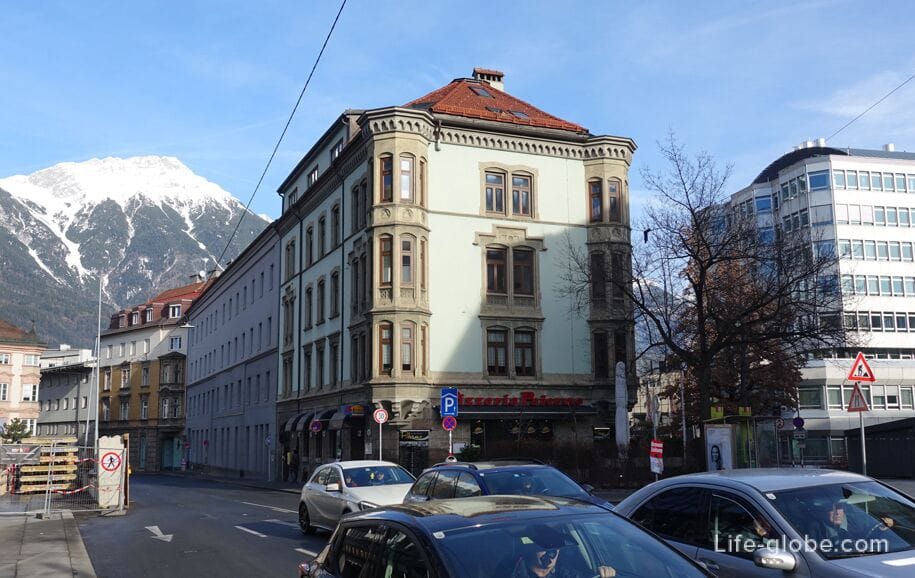

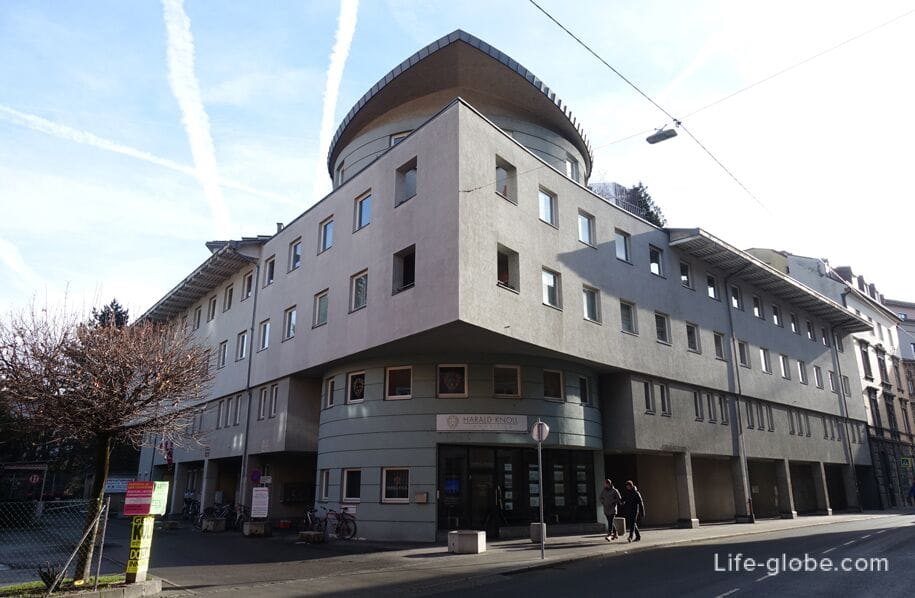
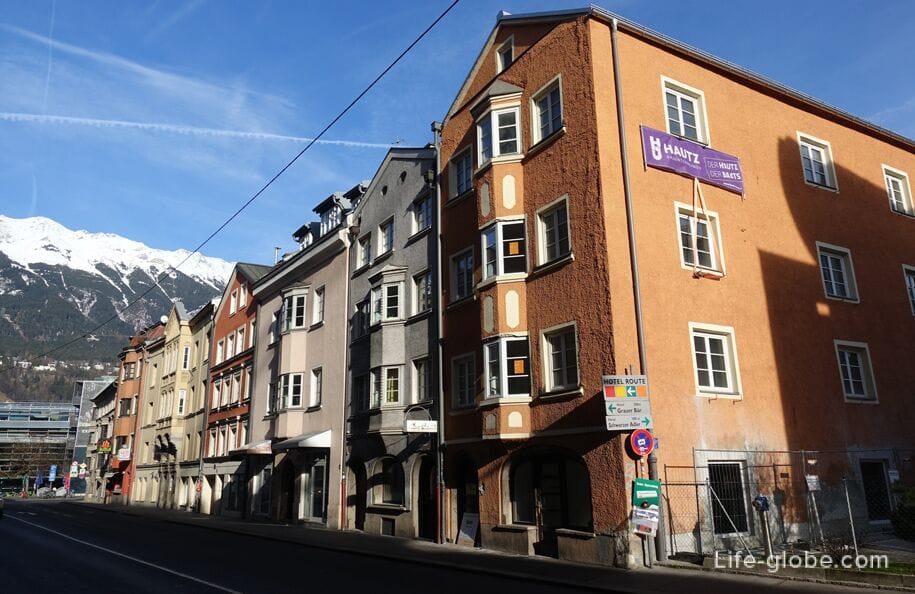
On the street Sillgasse remarkable:
historical building of the Theological University. Address: Sillgasse 8;
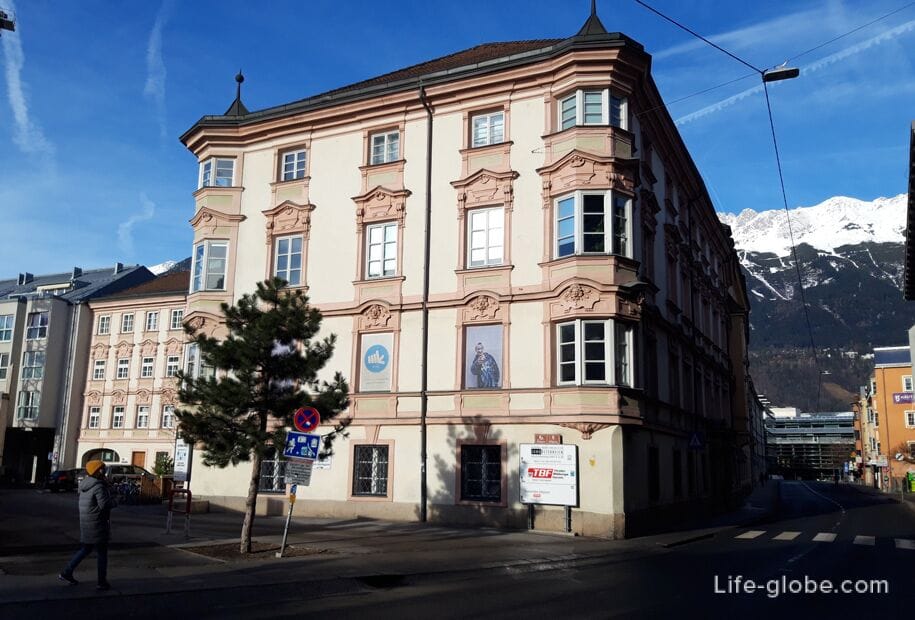
- the Jewish community of Tyrol and Vorarlberg. Address: Sillgasse 15;
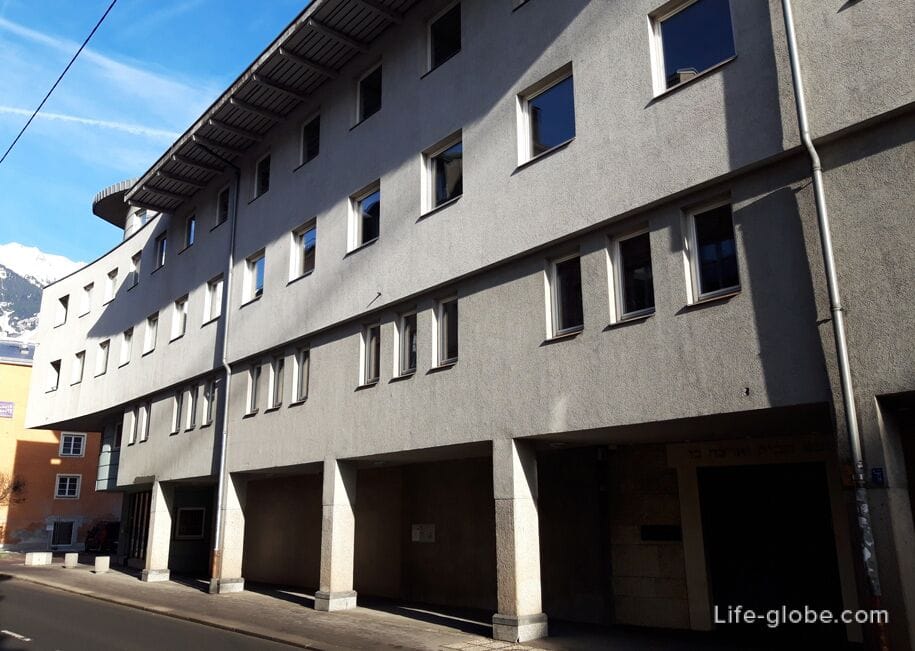
Jesuit College (Jesuitenkollege).
Petrus Konizi founded a College for the Jesuits in 1562 on Universitaetsstrasse. After the dissolution and reconstruction of the order (from 1773 in 1814), the College moved to a building on the street Sillgasse and expanded by acquiring adjacent buildings. The facade of the building gained its current appearance in 1911.
The address of the building of the College: Sillgasse, 6.
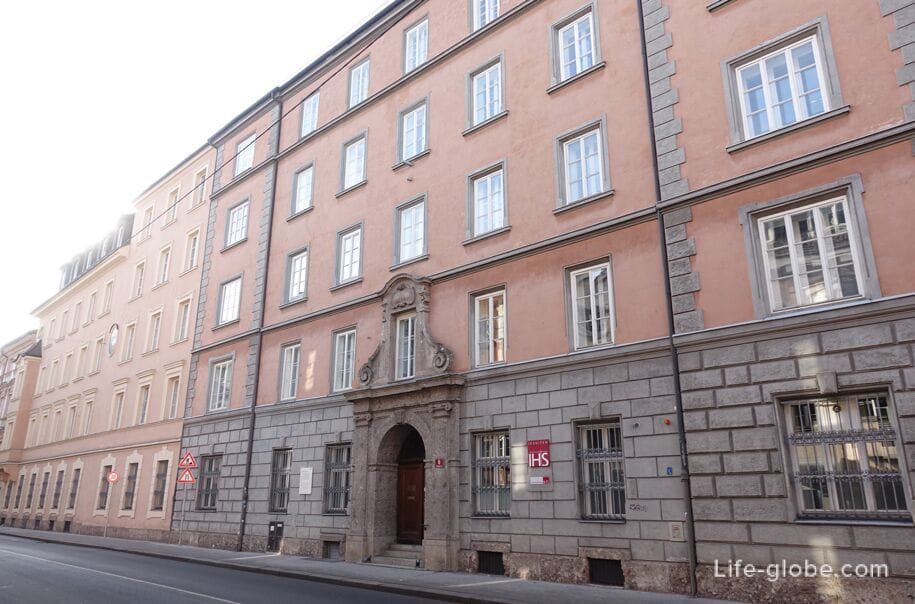
Universitaetsstrasse Street (Universitätsstraße)
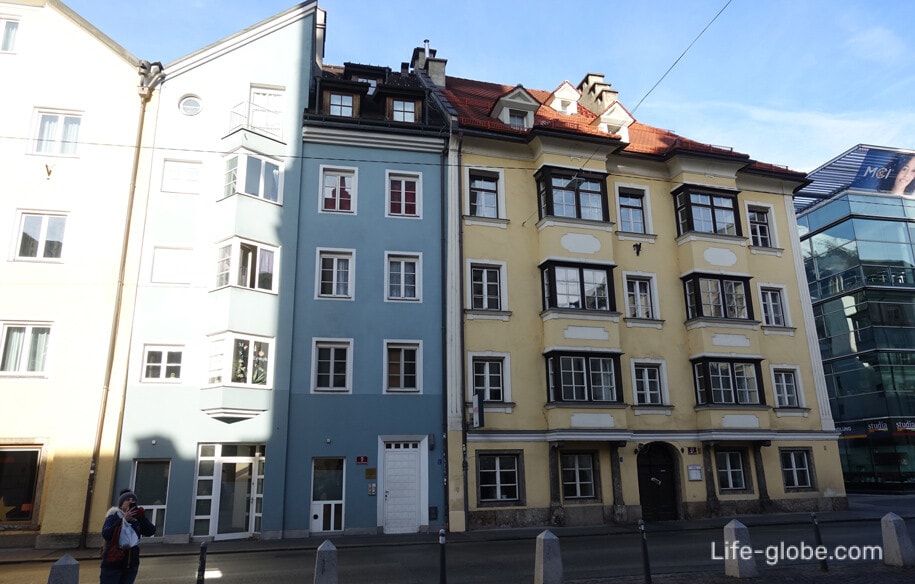

Herrengasse Street (Herrengasse)
Street is the North-Eastern border of the old town.
From the street you can see the tower and the dome of the Cathedral of St. James.
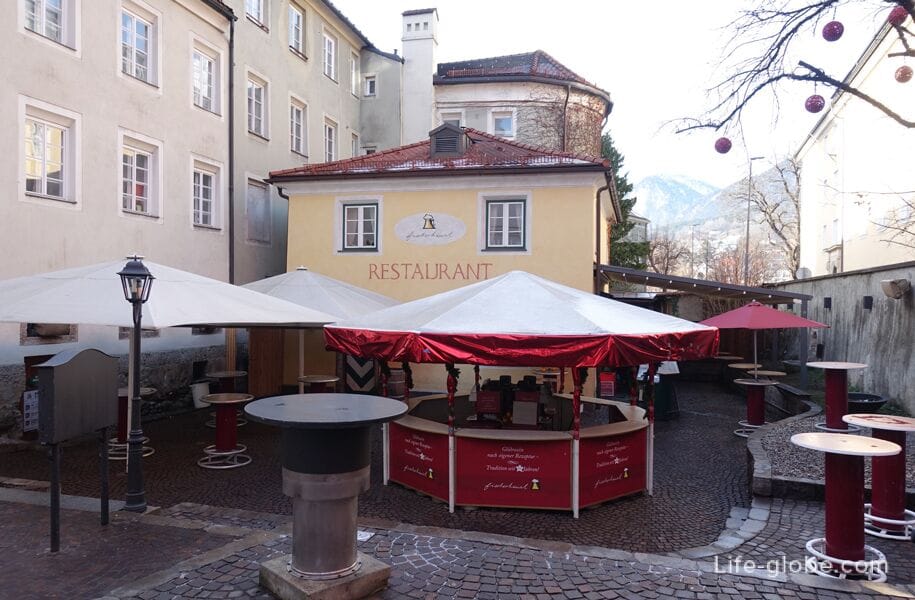
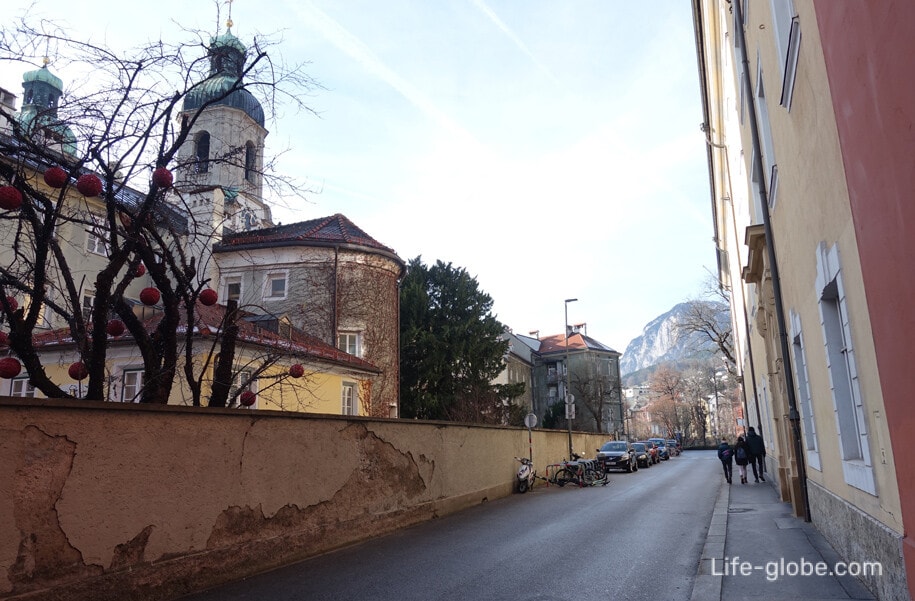

Street Innrain and the Herzog-Otto-Strasse (Innrain, Herzog-Otto-Straße)
Parts of these streets are the Western edge of the old town of Innsbruck, they are the same - the river Inn in Innsbruck.
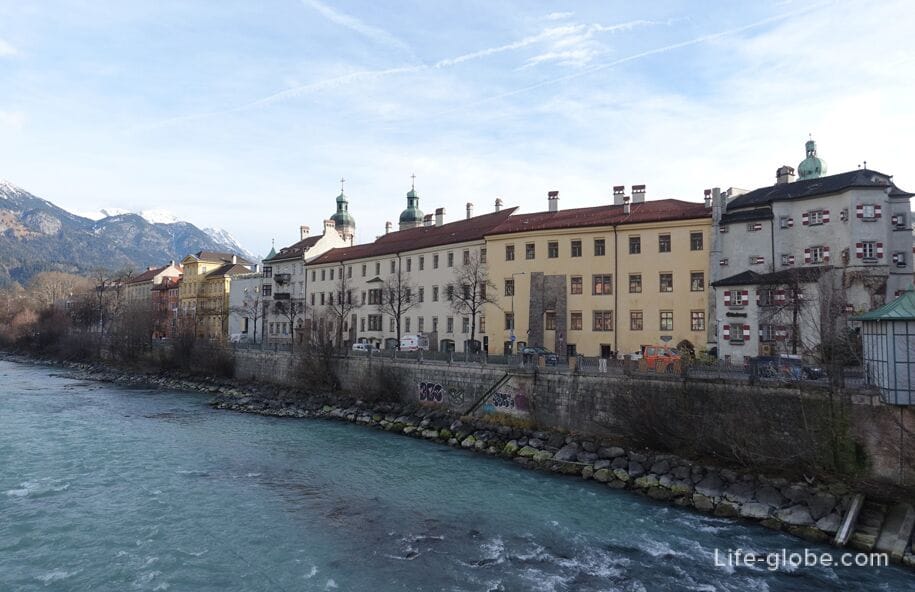
On the opposite - left (North) side of the Inn river, parallel to the old town of Innsbruck, a narrow strip stretches district Mariahilf-St. Nicholas (Mariahilf-St. Nikolaus), founded as a settlement around 1165, which related to the continuation of the historic city of Innsbruck.
This area is notable for historic buildings with bright facades, behind which rise the peaks of the Tyrolean Alps that creates a picture of unrivalled beauty. This panorama is depicted on many postcards, Souvenirs, as well as in brochures and guidebooks to Innsbruck. Read more about Mariahilf district-St. Nicholas...
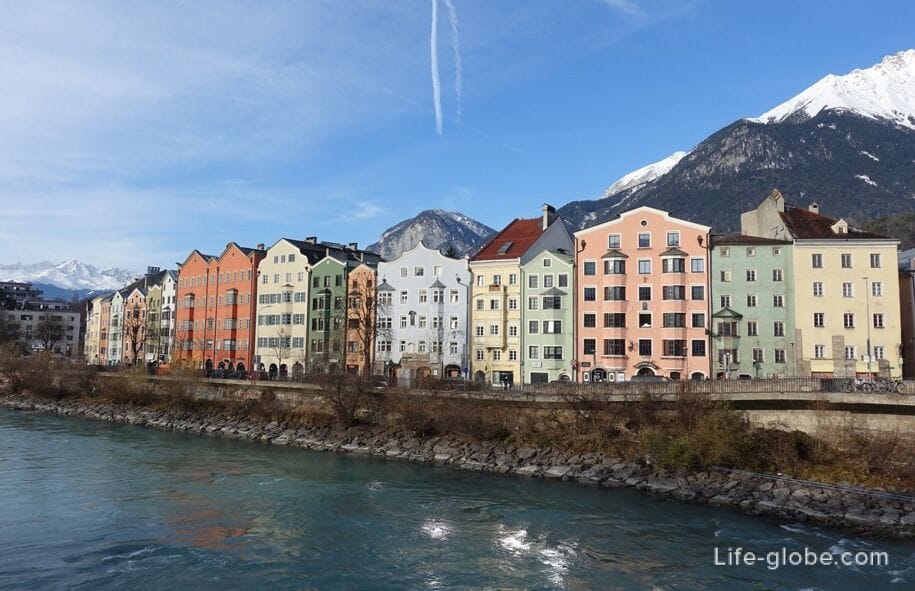
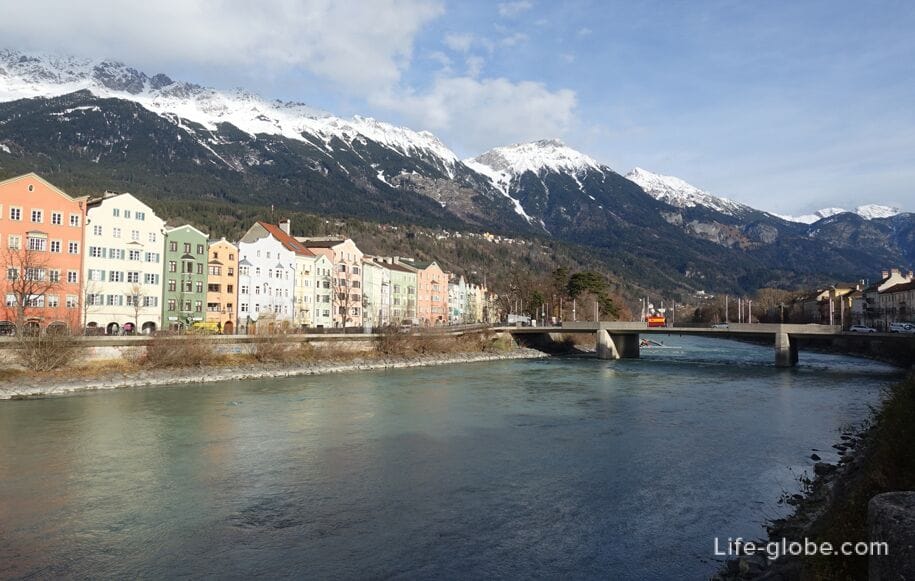
The old town of Innsbruck on the map
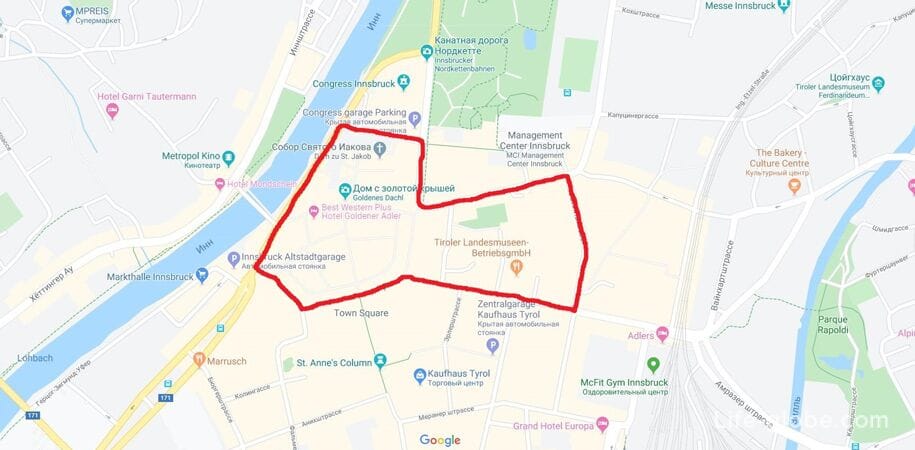
Where to stay in the old town of Innsbruck
4-star Hotel Innsbruck with free Wi-Fi, Parking, bar, indoor pool and 2 spas that you can visit for free.
The panoramic Spa area (Nude area) has large Windows overlooking the rooftops of the old town, bio - and Finnish saunas, an infrared cabin and a sun terrace.
It offers neodisco Spa centre, an indoor pool, a Finnish sauna, an aromatherapy steam bath and a floating tub.
In rooms: air conditioning, mini-bar, safe, flat-screen TV and a private bathroom. On request, rooms for guests with reduced mobility.
The room price includes: Breakfast or Breakfast and dinner. Link to the hotel
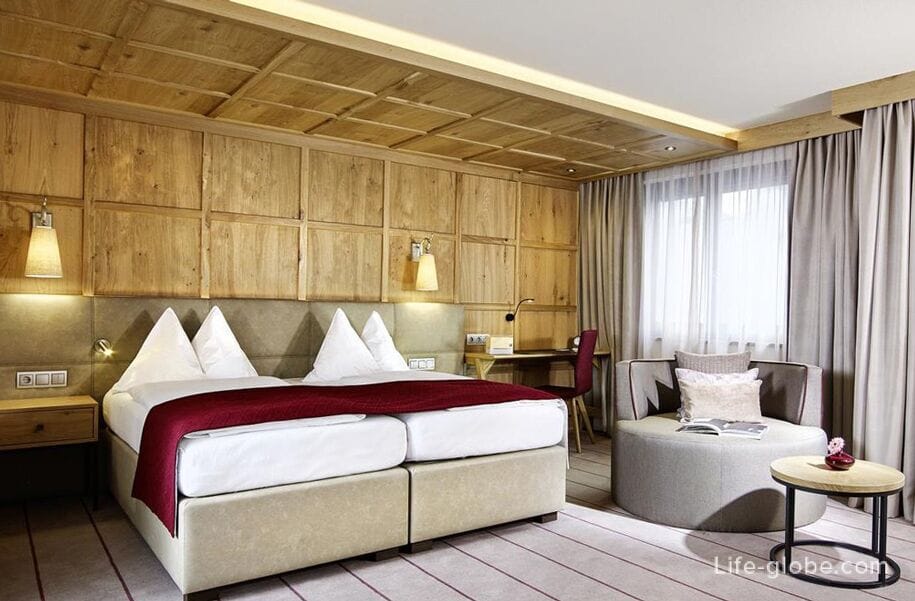
The 4-star BEST WESTERN Plus Hotel Goldener Adler Innsbruck with Parking, a bar, a restaurant where you can enjoy Tyrolean cuisine and facilities for guests with reduced mobility.
In the rooms: safe, air conditioning, free Internet access, TV with free Sky channels and a private bathroom with free toiletries.
Room rates may include Breakfast. Link to the hotel
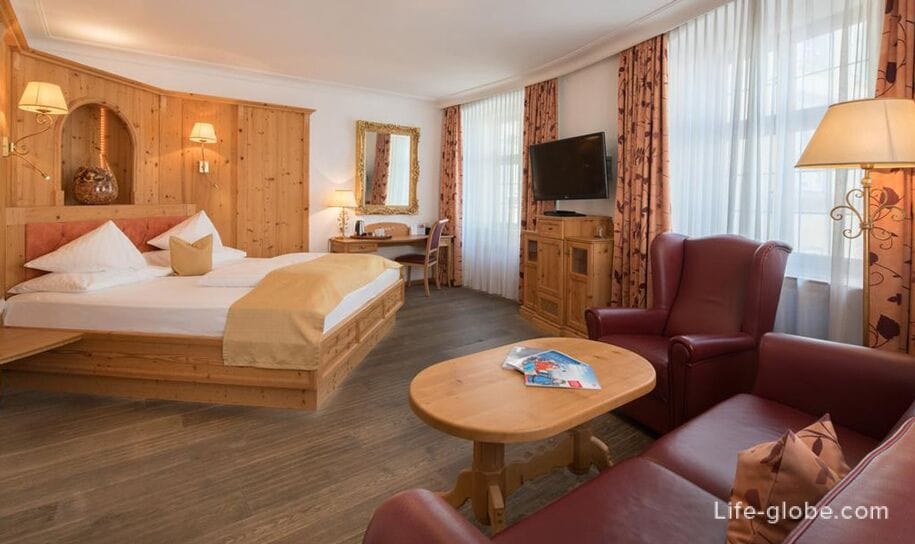
4-star hotel Grauer Bär with a panoramic swimming pool on the 6th floor, Spa centre, 2 restaurants and a bar.
The Woodfire restaurant serves steak specialities, including aged beef.
Room rates include Breakfast. Link to the hotel

4-star family-run hotel Maximilian - Stadthaus Penz with a business center, lift, storage room for skis, lobby, fireplace and Parking.
In the rooms: parquet floor, air conditioning, free Wi-Fi, a flat-screen TV and a Minibar. The bathrooms have a bath or shower.
Room rates may include Breakfast. Link to the hotel

The hotel Weisses Rössl restaurant with terrace, bar, free Wi-Fi and free Parking.
It offers spacious double and quadruple guest rooms.
Room rates include Breakfast. Link to the hotel
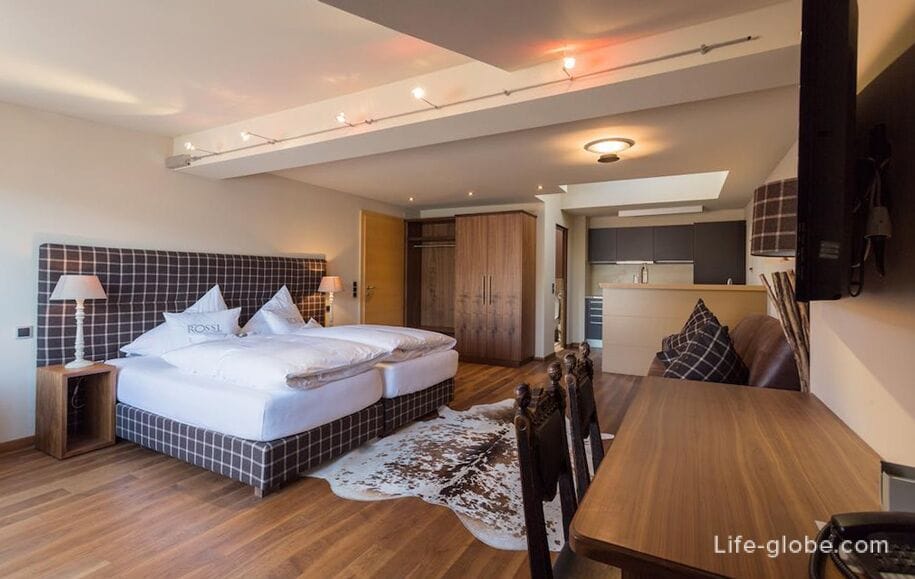
The 3-star hotel Happ with a restaurant, bar, free Wi-Fi and Parking.
Most rooms overlook the Golden roof.
Room rates include Breakfast. Link to the hotel

Apartments Golden Roof by Penz, located in a historical building overlooking the Golden roof and a public underground garage.
In apartment: free wifi, free ski storage, a kitchen, a flat-screen satellite TV, a Seating area with a sofa, a fully equipped kitchen and a private bathroom. The link apartments
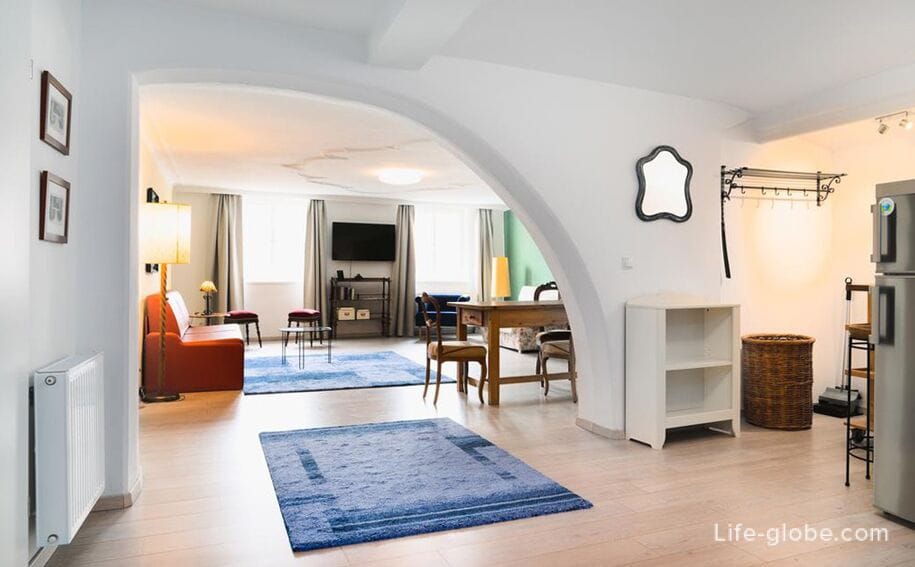
All accommodation in Innsbruck, including the old town and the historical centre, you can view and book here




